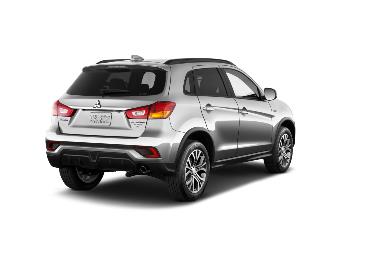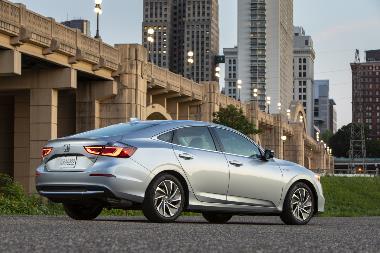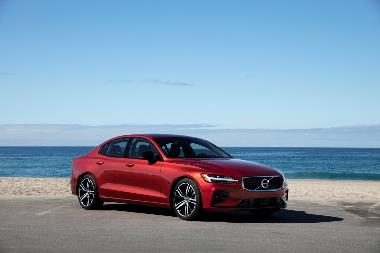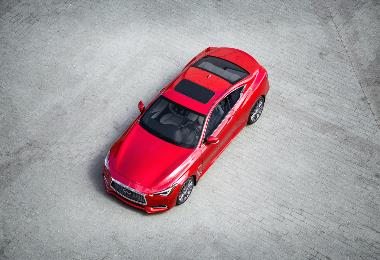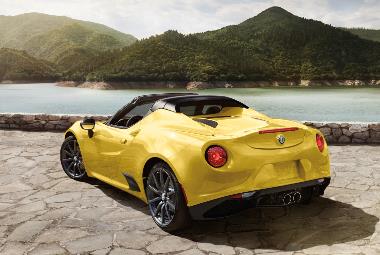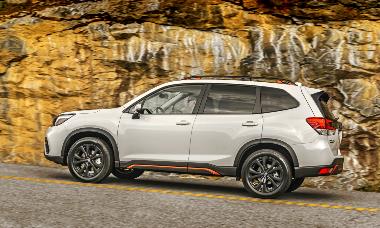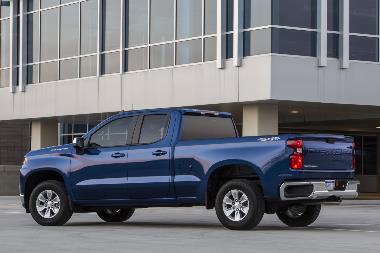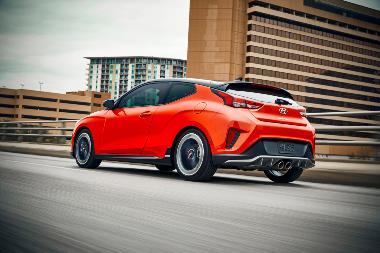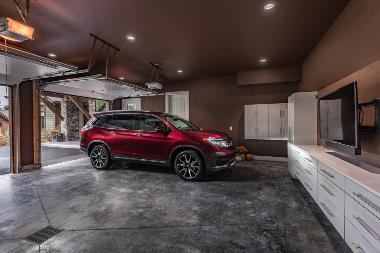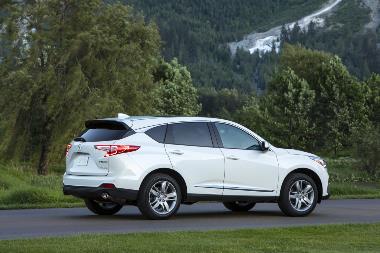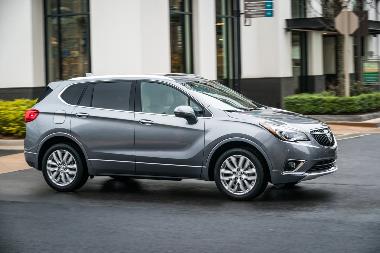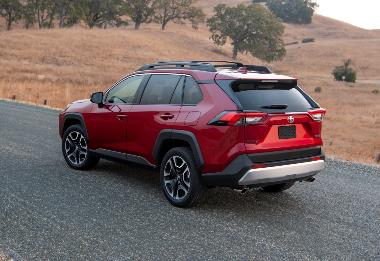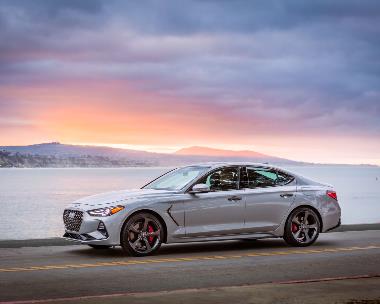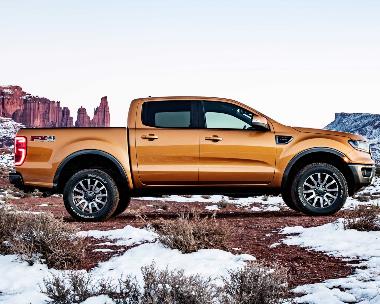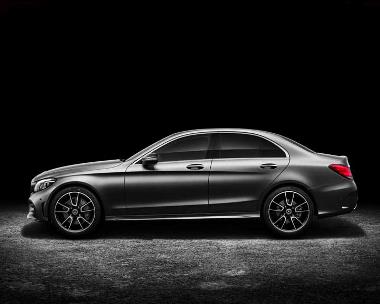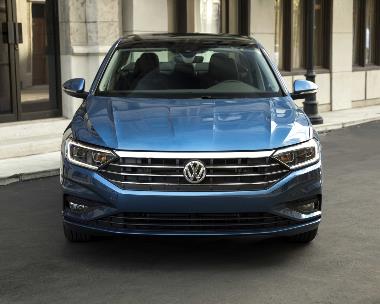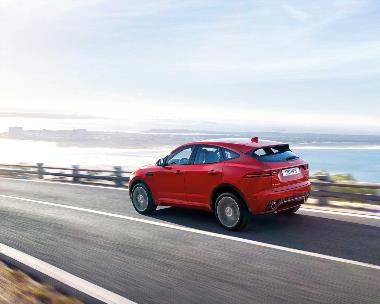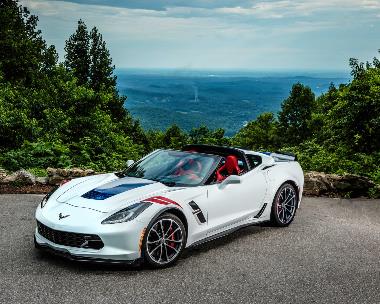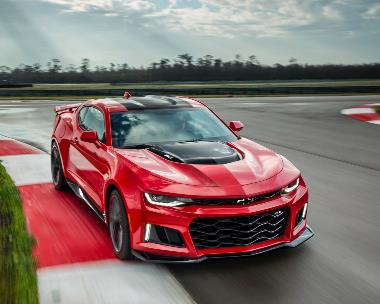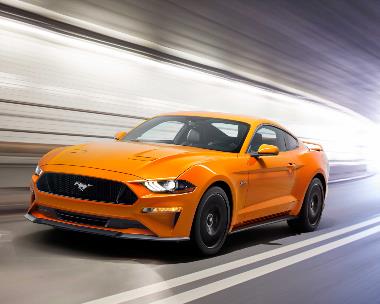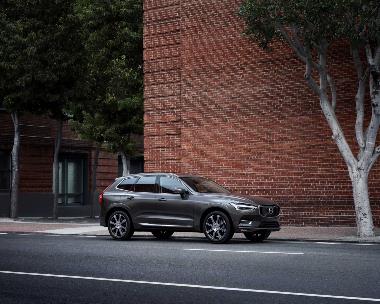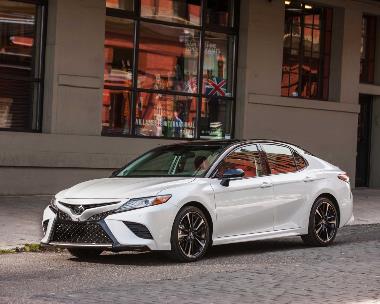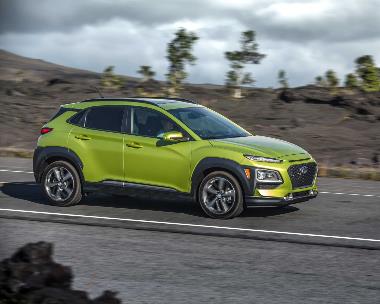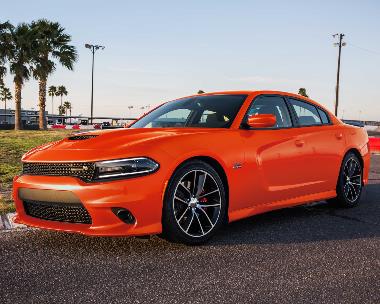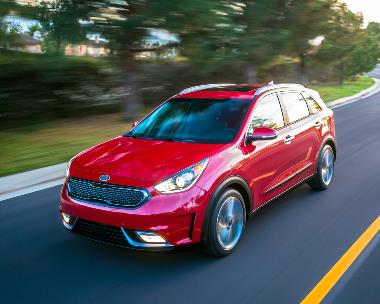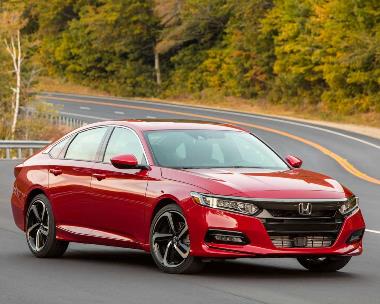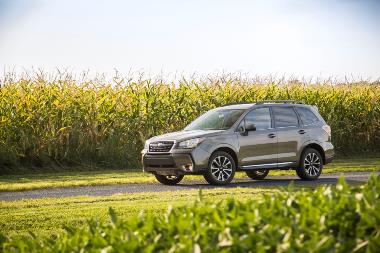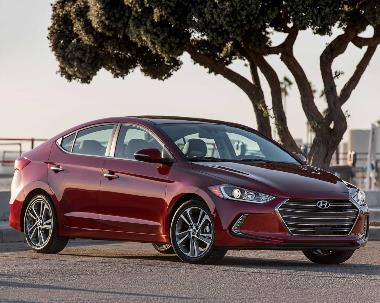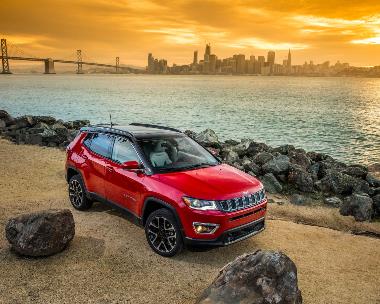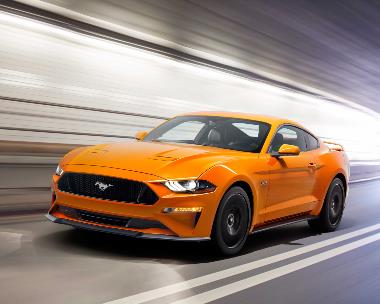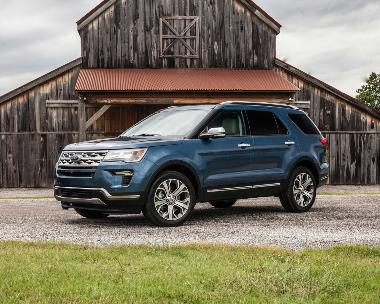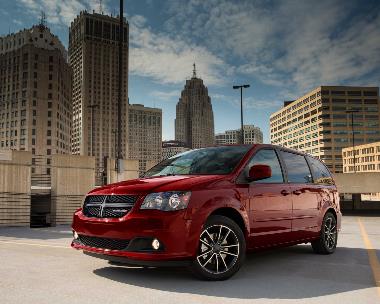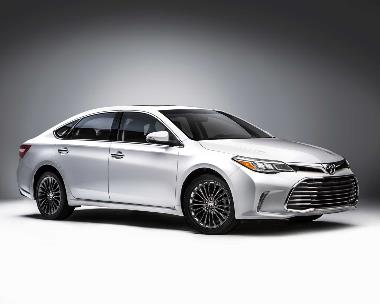
-
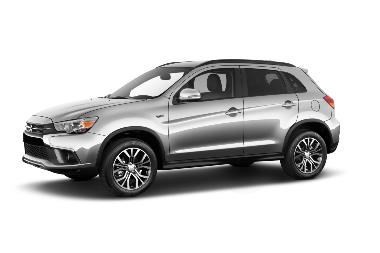
2019 Mitsubishi Outlander Sport 2.4: Small Crossover is sculpted, Athletic and Under $30K
Tuesday, Apr 23, 2019
Mitsubishi’s top-selling vehicle is its small crossover, the Outlander. Initially known as the Mitsubishi Airtrek, when it was launched in Japan in 20 …Mitsubishi’s top-selling vehicle is its small crossover, the Outlander. Initially known as the Mitsubishi Airtrek, when it was launched in Japan in 2001, the Outlander represents Mitsubishi’s take on the small crossover that offers all-season attention, and gentle off-road capabilities while promising lower-level emissions, good fuel economy and compact size.Show More
To attract those buyers yearning for more sportiness in their utes, even if they don’t take them off-road, Mitsubishi added the Outlander Sport in 2011, as a smaller, sportier and more affordable Outlander offering. Carrying the Outlander badge, the trendy Sport earned its own following as Mitsubishi’s entry-level crossover, positioned below the Eclipse Cross and three-row Outlander crossovers.
Available in 11 trims (nine with a 2.0-liter engine and two with a 2.4-liter plant), Outlander Sport remains in its first generation and adds only a few changes from 2018. What’s new? Well, Sport’s top SEL trim level get an up-market name – GT; and it comes with some great Active Safety additions. GT (along with the SE trim) gets standard Blind-Spot Warning, Rear Cross Traffic Alert and Lane Change Assist safety system; and the new GT trim gets as standard: Forward Collision Mitigation, Lane Departure Warning and Automatic High Beam Headlights.
Awaiting next year’s exterior massaging, the 2019 Outlander Sport is sculpted, athletic and small, to fit nicely in the “Under-$30K Compact Crossover” niche. The architecture is rounded and aggressively forward-leaning, utilizing an aerodynamic, low-drag body design with a clean, sloping demeanor, a short hood, raked windshield, angular corners and the “Dynamic Shield” grille bisected horizontally by a thick black centerpiece. Side action lines are sculpted in, and the rear employs a front-focused stance.
The Outlander Sport GT 2.4 -- my test drive -- is light at 3285 lbs. in AWD, and measures 171.9 inches long, 71.3 inches wide and 64.8 inches high on a 105.1-inch wheelbase. Ground clearance is 8.5 inches.
With two powertrain choices, Outlander Sport brawn comes from either a 2.0-liter MIVEC DOHC in-line 4 engine that provides 148 hp and 145 lbs.-ft. of torque, with an estimated 24 mpg city/30 mpg highway for 2WD models and 23 city/29 highway for AWD; or the 2.4-liter MIVEC inline-4-cylinder engine, which is rated at 168hp and 167 lbs.-ft. and is estimated 23/29 2WD and 23/28 AWD. Both engines are set up with a 5-speed manual or Sportronic® continuously-variable transmission.
My test Outlander Sport GT 2.4 was outfitted with the 2.4-liter engine that is less noisy than the smaller engine. But don’t let the name “Sport” influence your reason. Even with the 2.4, acceleration is lethargic, though predictable. Steady on uphill grades, passing requires some advance planning, and while comfortable and accountable on the highway, track tests were less-than-stellar, with a wearying 7.9-second zero-to-60mph sprint and a perceptibly slow 16.4-second quarter-mile. A week of mixed-use tests showed an average of 26.4mpg.
In the driver’s seat, Outlander Sport drives and feels more like a compact sedan than a small crossover. While the electric power steering seemed inattentive at times, in-town driving was fun and garnered some head-turns from onlookers. Maneuverability is athletic, and parking, tight-space exercises and obstacle-avoidance are no problem for the Outlander Sport GT. More at home in urban situations than off-road or soft-road, Sport GT is a feel-good drive rather than a rugged-ute, and you get good road feel and macadam imperfection-leveling with the MacPherson front struts with stabilizer bar and multi-link rear with stabilizer bar.
The Outlander Sport GT cabin is loaded with infotainment, connectability, leather and lots of plastic. Apple CarPlay, automatic climate control, rearview camera, heated front seats, Smartphone and multi-information displays, and a 7-inch touch panel display audio system fit nicely in the cabin. With seating for five, the interior provides 39.4 inches of front headroom with 37.9 inches for row two. Legroom is comfortable up front at 41.6 inches up front, and tighter, but adequate in the rear at 36.3 inches. Shoulder room is 56.2 inches in row one and 55.5 inches for the rear seats.
Outlanders come in various forms and start at various prices. The 2019 Outlander PHEV electric crossover starts at $35,795; the regular Outlander bases at $24,695, and the smaller, sportier Outlander Sport starts at $20,945. Available in nine trims with the 2.0 engine and two more with the 2.4, Sport tops out at $25,045-base for the 2.0 SE AWC. $20,395 for the 2WD ES 2.0 trim. The 2.4 engine model begins with the 2.4 SE at $25,045 and tops at $26,545 for the 2.4 Sport GT (my review ride) in all-wheel-drive automatic and gaining combination soft-touch seating surfaces, auto-dimming mirror with Homelink®, and All-Wheel Control. In Alloy Silver Metallic exterior paint and a black fabric interior, my Sport GT added Remote Engine Start for $545; LED fog lights for $350; and a cool Large Rear Spoiler for $310. The Popular Equipment Value Package added $200 for wheel locks, front and rear mudguards and an aluminum and leather shift knob; Park Assist Sensors added $465; and a Cargo Mat Package ($150), Carpeted Floor Mats ($135) and Tonneau Cover came with the selection. Destination and Handling Fees added $1095, for a sticker-as-tested of $29,985.
<I> Visit www.CarlisleEvents.com for more on the automotive hobby.
Mike Blake, former editor of KIT CAR magazine, joined Carlisle Events as senior automotive journalist in 2004. He's been a "car guy" since the 1960s and has been writing professionally for about 30 years. </I>
-
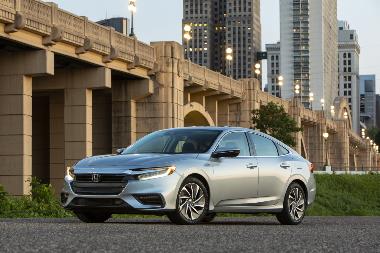
2019 Honda Insight: Former Hatchback Returns as a Compact Hybrid Sedan
Thursday, Apr 18, 2019
Discontinued twice since its initial launch in 1999, Honda’s Insight returns after a five-year hiatus, with a 2019 model that evolves from a five-door …Discontinued twice since its initial launch in 1999, Honda’s Insight returns after a five-year hiatus, with a 2019 model that evolves from a five-door hatchback into its current incarnation as a traditional compact sedan. The new third-generation Insight ups its game with a third-Gen two-motor hybrid powertrain, featuring a 1.5-liter Atkinson-cycle engine that runs on gasoline that works in tandem with a an electric motor and a lithium-ion battery pack.Show More
As Honda is on a program geared toward electrified vehicles that it believes will account for two-thirds of its global sales, Insight is designed to look mainstream rather than eco-electric. Moving toward that aim, the 2019 Honda Insight has been recognized as a “green” leader, as the American Council for an Energy-Efficient Economy named Insight to its “Greenest Vehicles of 2019” list. Additionally, Insight made the 2019 Consumer Guide® Automotive Best Buy Award list in the Compact Car niche, and was an IIHS (Insurance Institute for Highway Safety) Top Safety Pick and NHTSA (National Highway Traffic Safety Administration) top-score achiever.
Available in three trims, the front-drive compact hybrid bases with the well-appointed LX (automatic climate control, keyless entry and start, cloth upholstery, a 5.0-inch screen, Bluetooth, a six-speaker audio system, 16-inch alloy wheels, LED headlights, and a rearview camera); upgrades to the EX (my test ride) with an eight-speaker audio system, a center armrest for the rear seats, an 8.0-inch touchscreen, Apple CarPlay and Android Auto compatibility, and two 2.5-amp USB ports; and goes all-out with the Touring trim and its rain-sensing windshield wipers, a power moonroof, perforated leather-trimmed seating, heated front seats with 8-way power adjustment for the driver and 4-way power for the passenger, dual-zone climate control, a 10-speaker audio system, embedded Honda Satellite-Linked Navigation System™, Honda HD Digital Traffic, 17-inch alloy wheels and LED fog lights.
The 2019 Insight's body structure shares much of its engineering with the 10th-generation Civic, including the latest generation of Honda's proprietary Advanced Compatibility Engineering (ACE) body structure, extensive use of high-tensile steel, and leading technologies such as its crash stroke front frame design, which enables a shortened front overhang, and tailor-tempered “soft zones” in the body sides and rear frame for enhanced collision protection. Unlike Civic, the Insight utilizes an aluminum hood (skin and inner frame) for reduced weight and a new, reengineered rear that optimizes air-flow metrics.
The sleek lines, coupe-like profile, and wide stance of the new Insight communicate a sophisticated yet elegant design. Its “flying wing” grille, standard low-profile LED headlights and taillights, tasteful use of chrome, and dynamic character lines emphasize its premium compact sedan character. Longer, wider, lower and more stable than earlier incarnations, the 2019 Insight measures 183.6 inches long, 55.5 inches high and 71.6 inches wide, with a 200-lb, gain in curbweight at about 3000 lbs.
The driver-focused cockpit blends a graceful and wide layout with smoothly integrated technology features and high-quality materials. Premium details includes genuine double stitching on the passenger-side instrument panel, trendy and functional instrumentation, an intricately contoured sport steering wheel, a color TFT digital driver's meter and an overall premium feeling of the cabin.
Inside my test Insight EX was a surprisingly roomy interior that provides more room than ever, at 39.3 inches of front headroom with 36.9 inches in row two; 42.3 inches of front legroom and 37.4 in the second set of seats and 56.9 inches of shoulder room in row one with 55.0 inches in the rear seats. Interior sightlines are excellent and controls are well laid out and intuitive.
On the power front, the 2019 Honda Insight relies on the efficient 1.5-liter Atkinson-cycle gasoline engine and powerful electric drive motor combine for a system output of 151 horsepower and 197 lb-ft of electric motor torque. Under most conditions, Insight operates as a series hybrid -- the gasoline engine connects to a generator motor to produce electricity that either powers the electric propulsion motor, recharges the 60-cell lithium ion battery pack, or both. The Inline-4 delivers 107hp and 99 lb-ft of torque and while the Hybrid Derive Electric Motor is rated at 129hp and 197 lb-ft, the total system horsepower has a rating of 151 horses and an EPA rating of 55/49/52 mpg. My week of tests achieved an average of 46.0mpg.
While it is a fun drive, the electric motor responds quickly and the engine takes over when asked, with seamless aplomb. On the track, I managed a hand-timed zero-to-60mph sprint in 8.2 seconds on less-than stellar road surfaces, and completed a quarter-mile in 16.4 seconds. Handling was niche-good and brake vectoring helps carve tight corners efficiently.
The Base 2019 Insight LX starts at $22,930. My test LX trim test ride started at $24,160 – gaining connectivity and remote start, and added Safety from the Honda Sensing® system. The top-trim Touring starts at $28,190. My Lunar Silver Insight EX had a black cloth interior, and added Body Side molding for $225; Door Edge Guards for $99; Door Visors for $213; LED Fog Lights for $549; Auto-dimming Mirror with HomeLink® for $415; and Parking Sensors for $515. Destination and handling added $920, for a sticker-as-tested of $26,681.
> Visit www.CarlisleEvents.com for more on the automotive hobby.
Mike Blake, former editor of KIT CAR magazine, joined Carlisle Events as senior automotive journalist in 2004. He's been a "car guy" since the 1960s and has been writing professionally for about 30 years. </I>
-
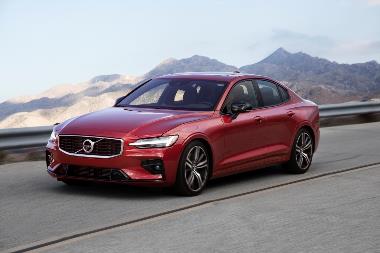
2019 Volvo S60: Swedish Luxury Sedan Made in South Carolina with New Styling, Powertrains and Connectability
Wednesday, Apr 10, 2019
Fully redesigned for 2019, the Volvo S60 uptweaks its styling, adds a hybrid and more powerful engine choices, includes a long list of standard and av …Fully redesigned for 2019, the Volvo S60 uptweaks its styling, adds a hybrid and more powerful engine choices, includes a long list of standard and available safety equipment, and connects with Sensus – Volvo’s connectivity and infotainment system that uses an intuitive touch screen interface that combines car functions, navigation, connected services and in-car entertainment applications such as Spotify, Pandora, Baidu or TuneIn.Show More
Now in its third generation, S60 is a mid-size luxury sedan that Volvo introduced in 2000 for the 2001 model year. Built at Volvo’s first American manufacturing plant, a facility outside Charleston, South Carolina, the company’s president and chief executive, Håkan Samuelsson, promoted the sedan saying, “The new S60 is one of the most exciting Volvo cars we’ve ever made. It is a true driver’s car that gives us a strong position in the US and China sedan markets.”
Borrowing design cues, power setups and amenities from its larger S90 sibling, S60 is built on Volvo’s Scalable Product Architecture modular platform that also underpins the S90. I tested the base S60 trim called Momentum, and I found that the 4-door mid-size focuses on the signature face of Volvo’s design language that includes elegant Euro lines, classic Volvo styling cues, sculpted hood creases, iconic “Thor’s Hammer” LED headlight design, a dignified honeycomb hexagonal grille, lower and bolder stance than before, long front end, curved and lower-looking roofline, angular shoulders and artistic tailllamp graphics. Aesthetically, S60 uses its grille and lower skid plate, sculpted hood creases, contoured lower shoulders and curved inset rear to create a sensually pleasing demeanor.
The elegant exterior combines lavishness with aggressiveness at 56.3 inches high (4.3 inches lower than the previous generation), 72.8 inches wide and 187.4 inches long (a gain of 5 inches) on a four-inch longer wheelbase (113.1 inches). Ground clearance is only 5.8 inches and curbweight for my test Momentum trim was 3913 lbs.
Inside, the quiet cabin plays off the clean, minimal Scandinavian influence that also fills Volvo’s 90 Series. Volvo’s orthopedic-designed seats really are comfortable and supporting, and they are heated, power-adjustable and Nappa leather-trimmed. An 8.0-inch instrument cluster display, 9.0-inch multimedia touch screen, Smartphone integration, Apple CarPlay and Android Auto connectivity add to the versatility of the interior.
The S60 cabin is pampering and accommodating, though over-6-footers may feel a bit confined with 37.9 inches of front headroom with a sunroof, and 37.5 inches in the rear. Legroom is 42.3 inches up front and only 35.2 inches in row two, and shoulder room is a comfortable 56.1 and 54.5.
In keeping with Volvo's reputation for safety, the new S60 comes with a complete suite of advanced safety features. You can also add Volvo's Pilot Assist semi-automated drive system for an extra layer of protection. And Volvo’s City Safety technology, standard on all Volvo models, combines automatic braking functionality and collision avoidance systems to cover a range of potential accident scenarios and help keep you safe. City Safety is the only system on the market that detects pedestrians, cyclists and large animals such as moose and deer.
The S60 offers four gasoline powertrains and is the first Volvo car to be sold without a diesel. Options include a T5 4-cylinder turbocharged 2.0-liter engine (250 hp/258 lb-ft) and theT6 AWD in-line 4 2.0-liter, supercharged and turbocharged engine (316 hp/295 lb-ft) that powered my test ride. There are also a T8 Twin Engine AWD in-line 4 2.0 supercharged and turbocharged engine (313 hp/295 lb-ft) and the T8 Polestar 2.0 supercharged and turbocharged plant (328 hp and 317 lb-ft). With quick and supple acceleration, my T6 powered up for a 5.9-second zero-to-60mph dash during a 14.4-second quarter-mile run. My week of mixed-use driving averaged 29.1 mpg, and I found the ride, quiet, controlled, but a bit rough over road imperfections. Handling responsively, the S60 steers predictably and handles curves in auto-cross fashion.
The 2019 Volvo S60 starts at $35,800 for the Momentum trim with the 250-hp T5 engine and 18-inch Momentum Alloy wheels. The R-Design trim starts at $42,545 and the Inscription level is $42,900. I tested the Momentum and upgraded to the T6 AWD and 316hp, to start the build at $40,300. Fusion Red Metallic exterior paint added $645 and was mated to a Charcoal (Black) Leatherette interior. A rear diffuser with split end pipes added $595. Inside, the cabin added the Premium Package ($2050) for automatically dimmed exterior mirrors, Blind Spot Information System and Cross Traffic Alert with auto brake, compass in rear view mirror, HomeLink™, keyless entry with illuminated door handles and hands-free trunklid, retractable side view mirrors, and
front and rear Park Assist. The Multimedia Package added a 12.3-inch digital instrument cluster, a Harmon Kardon Premium Sound system and Sensus Navigation Pro, for $2500. The Advanced Package added Active Bending Lights (as you steer, the headlights turn to illuminate the curve ahead), Graphical Head-up Display, Headlight High Pressure Cleaning, LED Front Fog Lights with Cornering Function, Pilot Assist - Driver Assistance System with Adaptive Cruise Control and Visual Park Assist + 360° Camera, for $2500, and the heated rear seats and heated steering package added $750. Rear mudflaps added $85 destination fees added $995, for a sticker-as-tested of $50,420.
<I> Visit www.CarlisleEvents.com for more on the automotive hobby.
Mike Blake, former editor of KIT CAR magazine, joined Carlisle Events as senior automotive journalist in 2004. He's been a "car guy" since the 1960s and has been writing professionally for about 30 years. </I>
-
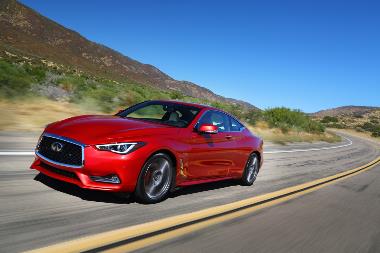
2019 Infiniti Q60: Stylish and Powerful Luxury Sport 4-Seater
Wednesday, Apr 3, 2019
The Infiniti Q60 is a 2-door sport luxury 4-seater coupe, not to be confused with the cross-over QX60. The Q60 is the successor to the Infiniti G Coup …The Infiniti Q60 is a 2-door sport luxury 4-seater coupe, not to be confused with the cross-over QX60. The Q60 is the successor to the Infiniti G Coupe and convertible, and began as a rebadged “G” for the 2013 model year. Unlike other alpha-numeric nomenclature in which the number is directly related to engine size (e.g. the old G37 stood for a 3.7-liter engine), the “Q” stands for sedan-class and the “60” is for the proposed relative ranking in the “Q” universe, where the entry-level Q is the Q50, the sporty convertible is called the Q60, the luxury Q is the Q70 and the cross-over is the QX with its own number placements.Show More
For 2019, the third year of its second generation, Infiniti has eliminated its old 2.0-liter turbo engine and has replaced it with a 3.0-liter twin-turbo setup, available in two power ranges. This year’s Q60 is offered in three grade levels – PURE, LUXE and RED SPORT 400 – the RED SPORT 400 gets its name from the traditional power production – a 400hp engine, as opposed to 300 horses for the other trims. And a few cosmetic packages have been renamed, while several previous options are now standard on the various trims, including standard automatic emergency braking on the uplevel offerings.
Building on Infiniti's luxury-sports sedan design, performance and technology, the Q60 delivers an in-motion appearance with its aggressive stance, low and wide proportions and muscular lines. Its low center of gravity enhances driving dynamics, and is augmented by trapezoidal, honey-comb grille and crescent-shaped C-pillars that arc forward. Signature LED headlights, employ light guide technology to spread light evenly on the road ahead, and are designed to emulate the shape of the human eyelid, providing an alluring face to the car. The deep grille is inset from the high-strength steel corrosion-resistant body and aluminum hood. The 2019 Q60 measures 184.4 inches long, 54.5 inches high and 72.8 inches long on a 112.2-inch wheelbase.
The well-appointed interior is cramped up top and in the rear, and the backseats are difficult to access, but the cockpit is tailored to meet a driver’s needs. The layout includes natural contour ergonomic-design front seats for enhanced comfort, premium leatherette seating surfaces, available semi-aniline leather-appointed seating, 8-way power-adjustable driver's seat with manual lumbar support (power available), 8-way power-adjustable front passenger seat, available power torso bolsters (driver's side), Infiniti Intelligent Key with Push Button Ignition, touch unlock door function, available heated front seats and heated steering wheel, Fine Vision electroluminescent instrumentation, premium 13-speaker Bose® sound system, Infiniti InTuition™ – a customizable digital environment for storing and providing various driver settings and driving characteristics to Intelligent Key, and much more. But as mentioned, interior dimensions are a bit tight north and south and in the rear, with 37.9 inches of front headroom and 34.5 inches in row two; legroom is comfortable at 43.1 inches in row one, but a child-worthy 32.4 in the rear; and shoulder room measures 54.6 and 52.0.
Available in rear-wheel-drive or all-wheel-drive, Q60 delivers power with its standard 3.0-liter longitudinal V-6 twin-turbo that provides 300-hp. 295-lb-ft of torque. The uptweaked Q60 Red Sport 400 model gets its numerics from a 400-hp, 350 lb-ft 3.0-liter V-6. The engines are teamed exclusively to a 7-speed automatic transmission, and the vehicle delivers when called upon. While inclement weather forced test track closures, my test LUXE trim should complete a zero-to-60mph dash in about 6 seconds, with a quarter-mile accomplished on about 14.5. Fuelwise, I averaged 22.8mpg during mixed-use tests.
Handling is quick-turn worthy and the power-assisted, vehicle-speed-sensitive rack-and-pinion steering is predictable, while the independent double-wishbone front suspension with a stabilizer bar, works well with a multi-link independent rear with a stabilizer bar for good road-feel without a harsh ride.
From a safety perspective, Q60 is outfitted with six airbags, LATCH connectors for child safety seats, brake assist, anti-lock brakes with electronic brake-force distribution, advanced vehicle dynamic control and traction control, tire-pressure monitoring and an emergency inside trunk release. Optional safety features include backup-collision intervention, blind spot monitoring, predictive forward-collision warning, forward emergency braking with pedestrian detection, blind spot intervention, lane-departure warning and lane-departure intervention with active lane control and front-seat pre-crash seat belts.
The 2019 Infiniti Q60 is available in three trims in RWD and AWD configurations, with the AWD adding $2000 to the base. The 3.0t PURE starts at $40,750. The 3.0t LUXE that I tested, started at $44,900 and the 400hp RED SPORT starts at $54,900. My test LUXE added AWD for that $2000 increase, and upgraded with the Essential Package ($3200) for Navigation with voice guidance, voice recognition, Lane Guidance and 3D building graphics, heated front seats and steering wheel, power tilt and telescoping steering column, dual-occupant memory system for driver's seat, steering column, and outside mirrors, driver's seat power lumbar and side bolsters, auto-dimming outside mirrors with reverse tilt-down feature and remote engine start system. A carbon fiber rear decklid spoiler added $870; carbon fiber look rear bumper protector added $50; remote engine start added $328; trunk protector added $120; Infiniti WiFi added $495; and destination and handling fees added $995 for a sticker-as-tested $52,958.
> Visit www.CarlisleEvents.com for more on the automotive hobby.
Mike Blake, former editor of KIT CAR magazine, joined Carlisle Events as senior automotive journalist in 2004. He's been a "car guy" since the 1960s and has been writing professionally for about 30 years. </I>
-
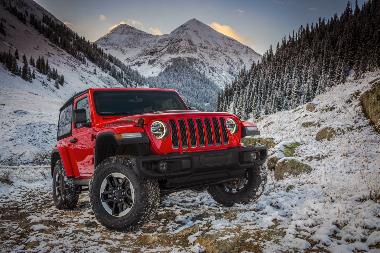
2019 Jeep Wrangler: Based on History and Ready for Adventure
Wednesday, Mar 27, 2019
The 1941 Willys Jeep was a military workhorse that has been called nostalgically, “the truck that won WWII.” Based on that concept, the Jeep Wrangler …The 1941 Willys Jeep was a military workhorse that has been called nostalgically, “the truck that won WWII.” Based on that concept, the Jeep Wrangler was born in 1986 as an evolution of the Jeep CJ-7. Wrangler was improved in 1996, updated again in 2006 and completely redesigned last year.Show More
Created to take its drivers and passengers on everyday adventures, the 2019 model adds to last year’s revamp with a new advanced safety group package that includes adaptive cruise control and forward collision warning. The 2019 Wrangler also adds a new exterior color – Bikini, which is similar to Turquoise. Five trims are available this year, and for those looking for adventure, Wrangler is available in multiple off-road configurations with different axle ratios, differentials, and transfer cases among the trim levels. Looking ahead, it is believed that a plug-in hybrid powertrain and a diesel engine might be available in 2020, and a Wrangler pick-up is on the horizon.
Built in Toledo Supplier Park, Toledo, Ohio, the multipurpose vehicle is laid out with a longitudinal front engine, four-wheel drive set-up on a ladder-type frame with an open steel and aluminum body. That body is Jeep-look all the way, from its seven-slot keystone-shaped grille in the manner of legendary Jeep® CJ models, to its trapezoid wheel flares, removable doors, exposed hinges with the Torx tool-bit size stamped into it, a fold-down windshield and innovative removable tops that allow the Wrangler to retain the brand’s iconic appearance and function.
Wrangler’s 118.4-inch wheelbase (for the 4-door -- 96.8 inches for the 2-door model) accommodates 188.4 inches in length (for the 4-door -- 166.8 inches for the 2-door), 73.8 inches in width and 73.6 inches in height. My Rubicon trim had a ground clearance of 10.8 inches and a curb weight of 4455 lbs. (for the 4-door -- 4145 lbs for the 2-door).
Jeep Wrangler’s interior is intuitive and driver-friendly with nostalgic styling that offers more comfort than one would expect in a rugged off-road-worthy vehicle. Precision craftsmanship and high-quality materials are found throughout the cabin, and the heritage-inspired center stack features a clean, sculpted form that complements the horizontal dashboard design and sports a finish dictated by the model choice. The cabin is packed with infotainment and ergonomic controls as well as more than 75 available safety features.
Roomy inside for front row driver and passenger, and somewhat tighter for second row travelers, headroom was 42.6 inches up front with the soft top and 41.7 inches in the rear; legroom was 41.2 inches in row one and 38.3 in row two; and shoulder room was 55.7 inches in both rows.
In terms of power, Wrangler offers two engine choices: the 3.6-liter V-6 manual which is standard on all models, is rated at 285hp and 260 lbs.-ft of torque and 17mpg/city and 23mpg/highway; and the 2.0-liter I-4 turbo is an option for all models, with 8-speed automatic rated at 270hp and 295 lbs-ft. of torque and is EPA rated at 22/24 mpg. I tested the Wrangler Rubicon with the 3.6 automatic setup mated to an eight-speed overdrive transmission, and I averaged 23.3mpg on some long-distance, around-town and soft-road driving.
On road or off-road, Rubicon performs. The solid axle front suspension with link coil, leading arms, track bar, coil springs, stabilizer bar and electronic sway-bar disconnect system with high-pressure gas-charged monotube shock absorbers with MTV technology and hydraulic rebound stop, works well with a solid axle rear, link coil, trailing arms, track bar, coil springs and stabilizer bar with high-pressure gas-charged shocks, for a comfortable ride on the highway while attacking potholes, road ruts and off-road obstacles. Low-end torque prevails over hill climbs, mud, snow and trails, and acceleration is solid for highway passing and off-the line fun. The electro-hydraulic power steering is tight and attentive, and while not an auto-cross star, it is fine for in-town maneuvers and fun for tree and brush skirting.
Wrangler power is predictable and sufficient to pass at speed, conquer uphill grades and get off the line quickly. My track tests were fun exhibitions, culminating in an 8.7-second zero-to-60mph dash and a 16.7-second quarter-mile.
There are five available 2019 Jeep Wrangler models, starting with the $31,545 Unlimited Sport 4x4 and moving through the MOAB at $51,300. The Rubicon trim I tested in Firecracker Red, is fourth up on the scale and starts at $41,545. My ride came with the standard 3.6-liter V6 engine … if you upgrade to the 2.0-liter I-4 Turbo, it will cost you an extra $1000. However, we did step up from the 6-speed manual transmission to the 8-speed automatic, for $2000. The Jeep Active Safety group added $995 for Blind-Spot and Cross-Path Detection, Parke Sense® Rear Park Assist and LED Tail Lamps; the Cold Weather Group option adds $995 for heated front seats, heated steering wheel and remote start; the 8.4-Inch Radio and Premium Audio Group added $1595 for an 8.4-inch touchscreen display, Alpine® Premium 9-speaker Audio System, GPS navigation, HD Radio® and auto-dimming rear view mirror; and Adaptive Cruise Control/Forward Collision Warning added $795. With Destination Charges of $1495, my 2019 Jeep Wrangler Rubicon as tested stickered at $49,420.
> Visit www.CarlisleEvents.com for more on the automotive hobby.
Mike Blake, former editor of KIT CAR magazine, joined Carlisle Events as senior automotive journalist in 2004. He's been a "car guy" since the 1960s and has been writing professionally for about 30 years. </I>
-
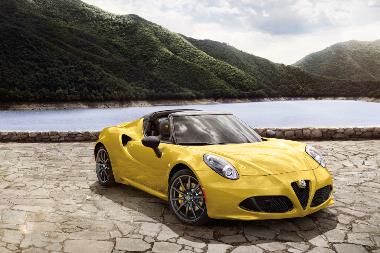
2019 Alfa Romeo 4C Spider: Exotic and Athletic Around Town and on the Track
Thursday, Mar 21, 2019
Spring is officially here, so let’s drive into springtime with something speeding away from winter. How about springtime in Italy, with the 2019 Alfa …Spring is officially here, so let’s drive into springtime with something speeding away from winter. How about springtime in Italy, with the 2019 Alfa Romeo 4C Spider convertible, assembled in Modena, Italy? The two-seater lives up to Alfa’s heritage, which began in Milan, Italy in 1910 … and it was the 4C that returned Alfa to the U.S. market in 2014, after a 20-year hiatus.Show More
Building on Alfa’s storied racing heritage, and its history of creating exciting, solid-handling, exotic, athletic vehicles, the 2019 Alfa Romeo 4C Spider offers driving enthusiasts a mid-engine design and represents the essential sportiness embedded in the brand’s DNA. Handcrafted in Modena, Italy, the Alfa Romeo 4C Spider offers seductive Italian styling and a state-of-the-art Formula 1-inspired carbon fiber monocoque and aluminum chassis that enables an impressive .95 hp to 10 lbs. power-to-weight ratio.
For 2019, Alfa has deleted the Spider hardtop coupe from the lineup, leaving only the convertible (with cloth targa top), and why not? Driving on a warm spring day, with the top down gets rid of the winter blahs in a heartbeat. New for this year, the 4C Spider complies with American federal regs with a rear backup camera, and Alfa has added standard rear parking sensors and cruise control. Additionally new stand-alone options include a race-tuned suspension; leather- and microfiber-wrapped steering wheel; and carbon fiber or Italian flag door-mirror caps.
The mid-engine rear-wheel-drive convertible is sport-sized with an overall length of 157 inches, width of 73.5 inches and height of 46.7 inches, on a 93.7-inch wheelbase, with a ground clearance 4.4 and a light curb weight of 2487 lbs. And its looks … well, it is Alfa, with hints of Lotus and Ferrari -- exotic, Euro-curved, angular and sculpted, with aggressive body creases. This is a sportscar, and when you drive it on the road, around town, or at the track, the gazes, nods and thumbs up from spectators are what feel-good cars are all about. Well, that and the performance.
The 4C Spider is powered by an all-aluminum direct injection 1750 (1,742 cc) inline-4 turbo engine that delivers 237hp and 258 lb-ft of torque. The all-aluminum plant is direct-injected with dual intercoolers and variable-valve timing, and is EPA rated at 24mpg in the city and 34mpg on the highway, for an average of 28mpg. My short week of mixed-use fun driving, with lots of tire-smoking and quick turns, yielded an average of 24.4mpg, but you should do better than that with more conservative driving … but why would you want to limit your fun? The one item that limited MY fun was that there are no manual transmissions available. Lack of customer demand prompted Alfa Romeo to only outfit the 4C Spider with a very precise and solid ALFA TCT (twin-clutch transmission). The setup is reliable and synched well, but not as much fun as a manual gearbox in a convertible sportscar.
The manufacturer says the 4C Spider will complete a zero to 60mph sprint in 4.1 seconds. I managed a 4.2 on a dusty track, with a hand-timed 12.8 quarter completed, but both times seemed much faster behind the wheel of this saucy convertible. On the interstate and even around town, with the top down, the engine growls, the wind whips, the 4C Spider deftly handles quick maneuvers and seems at one with its surroundings.
Athletic on the road and at the track … my 4C Spider responded and handled like an autocross star, and its response and handling live up to the Alfa track legacy, but the suspension is also track-oriented … with good road feel for the driver but invasive and susceptible to uneven spring roads around town. It is a rough ride for those not understanding road feel, and the tight steering is not exactly power steering, and if you are not in a sportscar frame of mind, it makes for a chore in tight maneuvering.
The cockpit is minimalistic – traditional sportscarlike. Short on infotainment, but cozy and meant for drivers, there is seating for two. Headroom is 38.0 inches with the top in place and endless when the convertible top is down; legroom is 42.7 inches and shoulder room is 49.8. Rear sightlines are tough, and the throaty engine and road noise are obvious with the top down and also harsh with the top in place. All are acceptable in a sportscar frame of mind, and less so in a touring mode.
From a safety perspective, the 2019 Alfa 4C Spider hits on all cylinders. The convertible is outfitted with advanced multistage front airbags, driver’s knee air bag, door-mounted side thorax air bags, energy-absorbing steering column, interior head-impact protection, passenger knee bolsters, 4-wheel anti-lock brake disc system, all-speed traction control system, electronic stability control, electronic launch control system, and more.
The 2019 Alfa Romeo 4C Spider starts at $66,900 plus a $1595 Destination charge. My test ride was bathed in a very energetic Giallo (Yellow) Protopo exterior paint, matched to a black and yellow interior for an additional $1500. My ride had upgraded 10-spoke silver wheels for $1800 and came with 205/40R18 and 235/35R19 3-season tires. Yellow brake calipers were an unnecessary cosmetic, but, OK, we got them for $450. An Alpine Premium Audio system, with subwoofer added $950, but the cabin is road and engine noisy (a good noise though), so I would suggest that you stay with the basic sound system and save the cash. The sticker-as-tested came to $73,195.
> Visit www.CarlisleEvents.com for more on the automotive hobby.
Mike Blake, former editor of KIT CAR magazine, joined Carlisle Events as senior automotive journalist in 2004. He's been a "car guy" since the 1960s and has been writing professionally for about 30 years. </I>
-
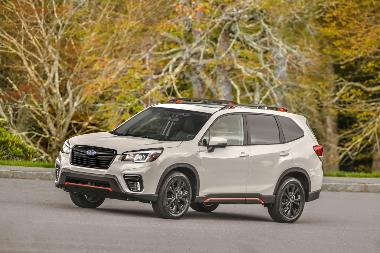
2019 Subaru Forester: Safety and Versatility are the Driver Focus
Wednesday, Mar 13, 2019
Only six years into its fourth generation, and two years removed from a solid style refreshening, the 5-passenger Subaru Forester compact SUV has ente …Only six years into its fourth generation, and two years removed from a solid style refreshening, the 5-passenger Subaru Forester compact SUV has entered a new generation with more power, a larger imprint and the addition of Subaru’s DriverFocus™ Distraction Mitigation System. In fact, Subaru of America, Inc. has centered its new ad campaign on it, with spots that gives viewers an intimate look into the lives of three different Forester owners by highlighting how the vehicle’s safety features, including the new Subaru DriverFocus™ Distraction Mitigation System, versatility and reliability, make the 2019 Forester the safest, longest lasting and most adventurous Forester ever, according to the manufacturer.Show More
The 2019 Forester is built on the Subaru Global Platform to deliver higher levels of agility, crash protection, ride comfort and quietness. Available in standard, Premium, Limited, Touring and new Sport trim levels, all Foresters are powered by an enhanced direct-injection, 182 hp 2.5- liter four-cylinder BOXER engine featuring Auto Stop/Start and paired with a standard Lineartronic CVT. Also standard on all trim levels is Subaru’s Symmetrical All-Wheel Drive.
Also for 2019, all Foresters come standard with the award-winning EyeSight Driver Assist Technology. The top-of-line Touring debuts the segment-exclusive DriverFocus safety technology which offers another layer of safety and convenience for the driver. The system uses facial recognition software to identify signs of driver fatigue or driver distraction and provides an audio and visual warning to alert the driver. DriverFocus also works with EyeSight to reduce the chance of an accident. And for added convenience, DriverFocus recognizes up to five drivers and remembers their seat and exterior mirror positions as well as multifunction display and climate control settings.
The 2019 Forester debuts a more rugged style that showcases Subaru’s new design language while retaining a strong family resemblance to the rest of the brand’s portfolio.
Inspired by the needs of outdoor enthusiasts, the 2019 Forester Sport, the trim model I tested, joins the line with unique appearance elements and specially enhanced standard equipment. A Sport grille with black gloss finish frame, black-finish 18-in. wheels and rear roof spoiler give Forester Sport a rugged look, while orange accents on the black underguards and roof rail mounts add a modern, youthful touch. The interior is a unique dark gray material with orange stitching and accents throughout that is exclusive to the Sport model. With unitized body construction, ring-shaped frame reinforcement frame safety structure, all Forester models feature lower body side cladding, which helps protect against mud, rocks and other road debris.
Longer and wider for enhanced road stability, but still within compact crossover SUV parameters, the 2019 Forester’s 105.1-inch wheelbase has gained 1.2 inches, to support its 0.6-inch longer 182.1-inch length, its 0.8-inch wider 71.5-inch width and 67.5-inch height (up 1.1 inches,) with ground clearance of 8.7 inches (same as before). Forester Sport weighs in at about 3531 lbs.
Inside, the Forester cabin is roomy with good sightlines. The Base Forester provides 41.2 inches of front headroom with 39.6 inches in the rear seats (actually losing 0.2 inches in both areas), and my test Sport trim was even cozier at 40.2 and 37.7 inches. Legroom is 43.3 inches in row one and 39.4 inches in row two (gaining 1.4 in the rear), with shoulder room gaining better than an inch at 58.2.and 57.2.
The quiet interior has been designed for both greater passenger comfort and increased durability in everyday and recreational usage. New front seats are constructed to enhance comfort on long drives, and a new Electronic Parking Brake frees up console space by eliminating the traditional parking brake handle.
All Forester models now feature standard automatic climate control; and Keyless Access with Push Button Start is standard on Sport, with climate controls that can be set when Remote Engine Start is activated.
All 2019 Foresters power up with a 2.5-liter engine that delivers 182hp and 176 lb-ft of torque (a gain of 12 and 2 over last year). Fuel economy is rated at 26mpg/city, 32mpg/highway and 28mpg combined, and I averaged 29.9mpg in mixed-use driving. More responsive, but not as quick as last year’s turbo (which has been discontinued), my test Sport finished off a zero-to-60mph sprint in 8.6 seconds during a 16.5-seccond quarter-mile. Highway passing at speed was predictable and efficient, and handling was somewhere between carlike and trucklike.
The 2019 Subaru Forester is available in five trim options. The Base Forester starts at $24,295; the 2.5i Premium starts at $26,295; the Sport begins at $28,795, the Limited starts at $30,795 and the Touring starts at $34,295 – the trim upgrades are largely concentrated in cosmetics and a few accessories.
My Crystal White Pearl Sport was matched to a Gray Sport Cloth interior and came with a moonroof. We added the $2045 Blind-Spot Detection/Rear Cross Traffic Alert Package with Reverse Automatic Braking, STARLINK 8.0-inch Multimedia Plus, Harmon Kardon Audio and a power rear gate. All-weather floor liners added $132; rear seatback protector added $93; the auto-dimming mirror with compass and Homelink added $365; side window deflectors added $99.95; splash guards added $172; and destination and delivery charges added $975, for a sticker-as-tested of $32,676.
> Visit www.CarlisleEvents.com for more on the automotive hobby.
Mike Blake, former editor of KIT CAR magazine, joined Carlisle Events as senior automotive journalist in 2004. He's been a "car guy" since the 1960s and has been writing professionally for about 30 years. </I>
-

2019 Chevrolet Silverado: Higher, Longer, Wider, Lighter and Still Tough
Thursday, Mar 7, 2019
Chevrolet has been producing iconic American trucks since 1918, and launched the Silverado as a trim level for Chevrolet C/K pick-ups and Suburbans fr …Chevrolet has been producing iconic American trucks since 1918, and launched the Silverado as a trim level for Chevrolet C/K pick-ups and Suburbans from 1975 through 1999, when it became its own line. Silverado continues its tough and capable truck legacy as it kicks off its all-new 4th Generation with the 2019 Chevrolet Silverado.Show More
Last redesigned for the 2014 model year, the 2019 Silverado is longer, wider, higher and lighter than Gen-3. Redesigned from the ground up, with an expanded range of eight models and six engine/transmission choices, Silverado’s wheelbase is up to 3.9 inches longer and it has an overall length that is 1.6 inches longer, enabling more cargo volume and more interior room for all cab lengths. And the 2019 Silverado is up to 450 pounds lighter than the previous model, thanks to advanced manufacturing and the use of mixed materials, including a fully boxed steel frame that is 88 pounds lighter than its predecessor, while offering 10 percent greater torsional rigidity.
Also re-engineered is the all-new Durabed with best-in-class cargo volume, with the short-box offering 63 cubic feet of volume with its bed floor width widened by nearly seven inches, while employing a higher-strength steel floor with yield strength increased for optimal strength and mass. You also get an all-new, segment-exclusive power tailgate and bed-mounted 120-volt power outlet; higher payloads and trailering ratings; more and stronger tie-downs – 12, with a doubled strength of 500 pounds of force before bending; and enhanced front and rear suspensions. Chevrolet has also improved the brake system, expanded its roster of safety systems and has added the next-generation Chevrolet Infotainment systems and connectivity to the setup.
My test Silverado 1500 LTZ with a Crew Cab fits full-size parameters. With a short 5-foot-8-inch box, the all-new Silverado measures 231.7 inches in length (the 6-foot-6-inch box adds 9.5 inches and the 8-foot box is not available with the Crew Cab). Silverado now measures a widebody 81.2 inches wide (up 1.2 inches) and a towering 75.4 inches high (for the 4x4), a gain of 1.6 inches, and some trims are as much as 78.4 inches high. All of this, on a 147.4-inch wheelbase. Ground clearance is 8.9 inches and step-in height measures 22.2 inches, while the Silverado LTZ’s base curb weight comes in at 5008 lbs. (a loss of nearly 300 lbs. for this trim) with the 5.3-liter engine and 4x4 configuration.
Inside, Silverado’s well-appointed, comfortable, safety-focused and tech-filled interior is roomy, quiet and functional, with a sturdy cab structure. Its Crew Cab provides 43.0 inches of front headroom (up 0.2 inches), with 40.1 in the rear (0.4 inches lower). Legroom is considerable, but shrunk 0.8 inches up front, to at 44.5 inches and 40.1 in the cab (0.8 inches tighter), while shoulder room measures 66.0 and 65.2 inches (you lose 0.5 in the cab).
Silverado powers up with five engine choices: a 2.7-liter turbo is rated at 310hp and 348 lbs-ft of torque; a 4.3-liter V-6 rated at 285 hp and 305 lbs-ft of torque, a 5.3-liter V-8 delivers 355 hp and 383 lbs-ft of torque, the muscular 6.2-liter V-8 with a 10-speed transmission thunders out 420 hp and 460 lbs-ft of torque, and there’s also a 3.0-liter turbo-diesel offered.
My Silverado LTZ with the 5.3 was muscular and attentive, easily passing speed, capably hauling heavy loads and effortlessly accelerating from a stop Proof at the track was a 6.6-second zero-to-60mph during a 15.0-second quarter-mile.
Fuel consumption was EPA rated at 16mpg/city and 22mpg/hwy with an AWD set-up and I averaged 19.8 in mixed-use driving on snow-encrusted roads.
My test Silverado LTZ was steady on uneven roads and softroad obstacles with its independent coil-over-shock front suspension with twin-tube shocks coupled with a solid axle rear with multileaf springs and splayed twin-tube shocks. The electric power-assisted rack-and-pinion steering was predictable and compliant,
The 2019 Silverado 1500 is offered in Regular Cab with standard box and long box; Double Cab Standard Box and Crew Cab in short box and standard box, and is configured in 2WD and 4WD. Base prices run from $29,895 with regular Cab and Long Bed to $33,795 for Double Cab standard bed, and $36,495 for Crew Cab and Standard Bed. My test 2019 Silverado 1500 2WD with a 4.3-liter EcoTec V6 came with a Crew Cab and short box, and included the 5.3-liter V-8 engine and six-speed automatic transmission, for $36,195. AWD made the ante $39,495 and an upgrade to the 5.3-liter engine moves it up to $40,890.
Eight trim packages are offered that can add from $1,000 to $18,000. My LTZ trim package – seventh on the list – came with 4WD, chrome grille, 18-inch Bright Silver painted aluminum wheels, Advance trailering features, perforated leather seating, and tons of standard trim items and moved the sticker to $50,295. We added the LTZ Premium package, discounted to $5350, for power sliding rear window with rear defogger, front buckets, power sunroof front center console, polished 20-inch wheels and 275/60R20 all-season, blackwall tires and more. The Technology Package added $1875 for a rear camera mirror, 8-inch diagonal digital driver information center, HD Surround Vision and head-Up display. And we added 6-inch black rectangular assist steps for $725. Destination and Freight charges of $1575 put the sticker at $59,245, but there was a $1000 Package discount and other incentives that put the buy price at $57,245, so check with your local dealer about incentives.
> Visit www.CarlisleEvents.com for more on the automotive hobby.
Mike Blake, former editor of KIT CAR magazine, joined Carlisle Events as senior automotive journalist in 2004. He's been a "car guy" since the 1960s and has been writing professionally for about 30 years. </I>
-
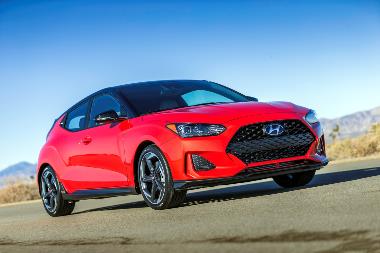
2019 Hyundai Veloster: Newly Designed Hot Hatch Turbo is Still Asymmetrical and Tons of Fun
Thursday, Feb 28, 2019
Launched for the 2012 model year as a coupelike, economic, subcompact hatchback to attract college-age drivers, the Hyundai Veloster has been redesign …Launched for the 2012 model year as a coupelike, economic, subcompact hatchback to attract college-age drivers, the Hyundai Veloster has been redesigned for its second generation, and in the words of Mike O’Brien, Hyundai Motor America’s vice president of Product, Corporate and Digital Planning “Our new 2019 Veloster represents an even more compelling offering for young and young-at-heart automotive enthusiasts with more expressive design, involving dynamics and cutting-edge infotainment features.”Show More
The fresh design was a collaborative effort of Hyundai designers from Seoul, South Korea and the U.S. design center in Irvine, California. The new Veloster features a new roofline, a new platform, a slightly larger exterior, increased power, enhanced safety, generous cutting-edge infotainment and connectivity features, and it retains its unique two-plus-one door asymmetrical bodystyle configuration (one large door on the driver’s side and two smaller doors in the passenger side).
Available in six trims -- Veloster 2.0, 2.0 Premium. Turbo, Turbo R-Spec, Turbo Ultimate and N -- each of the trim level is identifiable by different upholstery and pops of color on its seats and dashboard. Outside, the Veloster merges the design appeal of a sport coupe with the versatility afforded by the additional passenger side rear door.
From the front, available LED headlights and LED Daytime Running Lights flank Hyundai’s signature cascade grille shape with a strong, three-dimensional design. The rear spoiler with LED Center High Mount Stop Lamp, rear diffuser and functional air curtains add both a visual design cue and an active aerodynamic function.
Much of the redesign is derived from enhanced proportions and volume; the new shape suggests dynamic performance in a more muscular costume, with higher-volume fenders and wheel arches. The roofline has been lowered for a unique profile and a distinctive coupe-inspired essence. The fender line is also more coupe-like, and the rear now has a more aggressive integrated diffuser design.
The all-new Veloster bow measures 166.9 inches in length, 70.9 inches in width and 55.1 inches in height on a 104.3-inch wheelbase. Curbweight for the 2.0 is 2734 in AWD, while the turbos run above 2900 lbs. The 2019 Veloster is 0.8 inches longer and 0.4 inches wider than Gen-One, and it stands out with its own personality in the world of crossovers.
The asymmetrical design carries through to the interior, with a driver-focused interior layout and each trim level has unique colors, materials, and accents, further differentiating each model with varying hues and textures.
Inside, if you opt for a sunroof, Veloster gives you only 36.9 inches in front headroom and 35.9 inches in the rear seats. No sunroof gains you 1.2 inches in front and nothing in the rear. Legroom is 42.6 inches on tow one and 34.1 in row two; and shoulder room is a roomy 56.0 up front and 54.3 in the rear.
While rear sightlines are less than optimal, and rear seats are best left for children due to the tight accommodations, the cabin is packed with enhanced safety features, and such accouterments as a 6-way adjustable driver seat with seat height adjustment, power lumbar adjust for driver’s seat, heated front seats, 8-inch color touchscreen audio, Infinity® Premium Audio System with external amp and 8 speakers including a subwoofer, Bluetooth® hands-free phone system with voice recognition, Apple CarPlay™ and Android Auto™, rearview camera with dynamic guidelines, speed-sensitive automatic volume control, air conditioning, automatic temperature control with auto defogging, cabin air filter, 4.2inch color TFT instrument cluster, proximity key entry with push button start and much more.
Performancewise, Veloster is tons of fun. The base 2.0-liter 4-cylinder engine uses the Atkinson-cycle for superior efficiency and lower emissions and delivers a peak output of 147 horsepower, maximum torque of 132 lb.-ft. and is EPA rated at 26mpg/city, 33mpg/highway and 28mpg/average. My Turbo was powered by a 1.6-liter turbocharged, direct-injected four-cylinder engine that produced 201 hp and 195 lb.-ft. of torque (overboost can pop it to 202 lb-ft.) and is EPA rated at 28/34/30; and the Hyundai N gets a 2.0-liter turbocharged engine with up to 275 hp and 260 lb.-ft. of torque. My 1.6 got me an average of 29.9mpg in mixed use tests and was a beast at the track.
The MacPherson strut front suspension with coil springs, gas filled hydraulic twin-tube shock absorber and stabilizer bar combined with a Multi-link rear suspension with Hydraulic twin-tube gas-filled shock absorber gave me great road feel while smoothing out highways and in-town irregularities; and the Motor Driven Power Steering Rack and pinion steering was attentive, predictable and auto-cross worthy.
Acceleration was rocketlike, albeit, with a turbo beat to engage, and I managed a hand-timed 6.8-second zero-to-60 sprint and a 15.3-second quarter-mile. And the get-up, maneuvering and highway in-and-outs of traffic were a joy.
Base priced at $18,500 for the Base 2.0 and $26,900 for the top-speed and top-scale Veloster N, my test Veloster Turbo started at $25,400.with a wide sunroof, perforated leather-wrapped steering wheel, heated front seats,18-inch alloy wheels, and Blind-spot Collision Warning. In Sonic Silver, my Veloster came loaded with standard trim items and only optioned up with $125 carpeted floor mats and a $70 rear-bumper appliqué to minimize rear scratches below the liftgate. Adding a $920 freight charge, my 2019 Hyundai Veloster Turbo stickered at $26,515, but $1750 incentive discounts may be available in your area, so check with your local dealer.
> Visit www.CarlisleEvents.com for more on the automotive hobby.
Mike Blake, former editor of KIT CAR magazine, joined Carlisle Events as senior automotive journalist in 2004. He's been a "car guy" since the 1960s and has been writing professionally for about 30 years. </I>
-
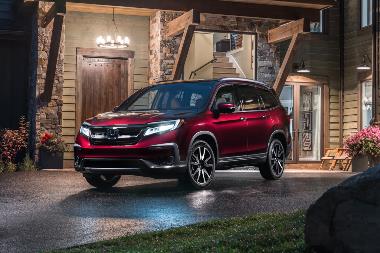
2019 Honda Pilot: 8-seat Family Adventure SUV Gets Mid-Generation Restyling and New Tech Capabilities
Thursday, Feb 21, 2019
Since Honda Pilot was introduced to the public in 2002, as the first three-row, mainstream SUV to be developed on a car-like unit-body platform, it …
Show MoreSince Honda Pilot was introduced to the public in 2002, as the first three-row, mainstream SUV to be developed on a car-like unit-body platform, it has been a favorite in America, as the 2 millionth Pilot was sold in North America in January, and its top sales year coming last year with 159,615 units sold in North America. Pilot also has garnered high brand loyalty, with approximately 63 percent of Pilot buyers returning to purchase another Honda vehicle.
Last re-engineered from the ground up for the 2016 model year, the family adventure vehicle gets a mid-generation freshening for 2019 with restyling, added tech capabilities and new features.
Borrowing inspiration from Honda’s Odyssey minivan, the 2019 Pilot restyles with an aggressive new grille featuring a bold interpretation of the Honda “flying wing” design, and sporty front fascia with standard LED low-beam headlights. The rear features new taillights, a new bumper, and chrome accents. Updates to the interior include a redesigned steering wheel, new trim around the vents and wider fold-down armrests for the driver and front passenger. Additionally, the clock-radio-style digital speedometer and analog tachometer have been replaced with a larger high-res central screen and enhanced infotainment system. The 2019 augmentations also include a number of refinements to the 9-speed automatic transmission available in Touring and Elite models, and the Honda Sensing suite of advanced safety features is now standard for all trims.
The eight-person family utility vehicle is built with unit-body construction with angular architecture and a muscular demeanor. The 2019 Pilot measures 196.5 inches in length; 78.6 inches in width; and a wind-attracting at 70.6 inches in height on a 111.0-inch wheelbase. Ground clearance is 7.3 inches, and curbweight ranges from 4036 lbs. to 4306 lbs. depending in trim and extras.
Inside, Pilot is filled with soft-touch materials throughout the cabin and tech runs supreme throughout and now benefits from a variety of enhancements and upgrades to its audio/connectivity and driver convenience. Pilot's new instrument cluster now uses a 7-inch Thin Film Transistor with a wide range of information content and driver-selectable customizable features.
Standard in Pilot EX trims and above, its 8-inch touchscreen uses gestures common to smartphones and tablets, such as swipe, tap and pinch, to control the vehicle's audio system, display settings and other advanced features, while also adding a volume knob. Pilot LX, EX, and EX-L models get a 218-watt audio system with six speakers plus a subwoofer; and Touring and Elite models get an updated 10-speaker 590-watt system with a subwoofer.
The Pilot cabin is accommodating, with headroom for the EX-L I tested of 39.5 inches up front (some trim models reach 40.1 inches), 39.9 inches in row two and 38.9 in row three. Legroom is 40.9 inches in the front row, 38.4 inches in the middle row and a child-accommodating 31.9 inches in row three. Shoulder room comes in at a comfy 62.0, 62.0 and 57.6.
The 2019 Pilot powers up with a 280hp, 262 lb-ft of torque 3.5-liter V6 engine. Depending on the trim model, it is mated either to a 6-speed automatic or 9-speed automatic transmission. My EX-L trim was outfitted with a 6-speed and was EPA rated at 18 mpg/city, 26mpg/highway and 21mpg overall in AWD. My mixed-use tests showed an average of 21.1mpg.
My Pilot showed good road manners, a quiet cabin and a smooth, bump-resistant experience. The unit-body construction body and chassis are mated to a MacPherson Strut Front Suspension and a Multi-Link rear with front and rear stabilizer bars, resulting in a level and attentive experience. Electric Power-Assisted Rack-and-Pinion Steering is compliant and understeer is apparent only in the quickest of maneuvers.
Acceleration is better than expected for a 3-row family mover, and handling is a bit vague. But zero-to-60mph tests were accomplished in 6.6 seconds, with a quarter-mile dispatched in 15.2 seconds (hand-timed) in less-than-perfect road conditions.
Honda remains committed to safety, and for 2019, all Pilot models come standard with the Honda Sensing® suite of advanced safety and driver-assistive technologies. Honda Sensing® helps provide greater awareness of driving conditions around the vehicle, and in some cases helps drivers maintain lane position. Comprising the Honda Sensing® suite are Collision Mitigation Braking System™ with Forward Collision Warning; Road Departure Mitigation; Lane Keeping Assist System; and Adaptive Cruise Control.
The 2019 Honda Pilot is available in five trims, starting with the LX at $31.450 for 2WD; the EX starts at $34,330; the EX-L starts at $37,760; the Touring trim starts at $42,540 and the top-of-the-line Elite trim starts at $48,020. My Obsidian Blue Pearl test EX-L was loaded with standard items including a leather-trimmed interior, power tailgate, one-touch power moonroof, two-position memory for driver's seat, 4-way power passenger's seat, automatic-dimming rearview mirror, integrated 2nd-row sunshades, HomeLink® remote system and three USB charging ports. I always opt for 4WD and that added $1900 to the sticker. Body side molding added $225; crossbars with black roof rails added $750; low-profile hood air deflector added $100; black running boards added $450; my Gray leather interior added all-season floor mats for $208; and back-up sensors added $500. With destination and handling fees of $1045, my test 2019 Honda Pilot EX-L stickered at $42,438 (by comparison, that is only $8 above the similarly outfitted 2016 EX-L I tested for this column.
> Visit www.CarlisleEvents.com for more on the automotive hobby.
Mike Blake, former editor of KIT CAR magazine, joined Carlisle Events as senior automotive journalist in 2004. He's been a "car guy" since the 1960s and has been writing professionally for about 30 years. </I>
-
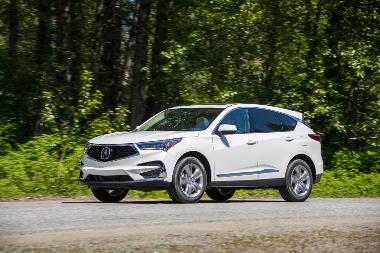
2019 Acura RDX: New Generation Changes Add Style, Power, Length, Performance
Thursday, Feb 14, 2019
Acura revamped and upleveled its luxury SUV lineup in 2001, when it replaced the SLX with a newly initialed mid-size crossover that was created to sup …Acura revamped and upleveled its luxury SUV lineup in 2001, when it replaced the SLX with a newly initialed mid-size crossover that was created to supply “Multi-Dimensional luXury," or MDX. In other Acura initialese, RDX hit the scene as Acura’s first luxury crossover SUV in 2006, and for 2019, RDX is all-new for its third generation. Now, RDX may mean Rapid Detonating Explosive in military terms, but RDX letters have no special meaning -- just a marketing grouping of letters. However, RDX is special, as the 2019 version is the first in a new generation of Acura models designed and engineered around Acura's innovative Precision Crafted Performance brand values. A top-seller in the premium compact SUV niche, RDX’s new generation model the first to be designed and engineered in America, with styling design conducted in the Acura Design Studio in Los Angeles, California, and development conducted by Acura’s engineering team headquartered in Raymond, Ohio, adjacent to the RDX's manufacturing home in East Liberty, Ohio where RDX is produced using domestic and globally sourced parts.Show More
New for 2019 are such powertrain items as a VTEC Turbo® 2.0-liter, DOHC direct-injected inline-4 engine, 10-Speed Automatic Transmission with Sequential SportShift, Acura Super Handling All-Wheel Drive™ and 4-mode Integrated Dynamics System.
But the first things you see are exterior changes that include: improved aerodynamics with specially shaped front-end components, a more rigid, lightweight and acoustically sealed chassis, repositioned rear spoiler, and a rounded in-motion demeanor. Interior augmentations include Acura True Touchpad Interface™ with 10.2-inch HD display, Acura sports seats with available full-grain perforated Milano leather and up to 16-way power adjustment (12-way standard), Natural Language Voice Recognition, Frameless interior rearview mirror with integrated HomeLink™, available heated steering wheel and available Surround-View Camera System.
The 2019 RDX strikes a more aggressive and athletic pose with a long and wide stance, wheels pushed to the corners and sharply sculpted design details. Premium exterior details include all-LED lighting featuring the next generation of Acura's Jewel Eye™ LED headlights and an ultra-wide power tilt and slide panoramic moonroof, standard on all grades. Gaining length, width and height, RDX now measures 186.8 inches long (up 2.4 inches), 65.7 inches high (0.7 inches higher) and 74.8 inches wide (1.1 inches wider) on a 108.3-inch wheelbase (2.6 inches longer) and weighing in at about 3783 lbs. (47 lbs. lighter). Ground clearance is about the same at 8.2 inches.
The new RDX has changed its muscle delivery system for an interesting approach to more power and better acceleration. Available with either front-wheel drive or all-wheel drive configurations, RDX is now powered by a new direct-injected and turbocharged 2.0-liter 16-valve DOHC inline-4-cylinder engine with VTEC® valvetrain. Mated to a niche-first 10-speed automatic transmission, there is a peak output of 272 horsepower and 280 lb-ft of torque. That’s down seven ponies from the last-gen 3.5-liter naturally aspirated V-8 model, but that’s made up for by the increase of 28 lb-ft of torque. What you get is better off-the-line and passing acceleration, and higher efficiency. Reliable on uphill grades, passing at speed and low-end around-town performance, RDX surprised me at the track with a (hand-timed) 5.8-second zero-to-60 sprint and a 14.5-second quarter-mile.
Fuel efficiency was solid for the segment with an EPA rating of 21mpg/city, 27mpg/highway and 23mpg/combined. My 400 miles of mixed-use tests showed an average of 22.2mpg; and handling was also better-than-expected for the segment, with little understeer, a smooth ride and average body sway and top wobble during autocross maneuvers.
The new RDX offers a high level of convenience and new technology in a more spacious cabin. High-end appointments, including authentic brushed aluminum accents and available genuine Olive Ash wood trim, hand-wrapped and stitched leather trim, and softer, more durable full-grain Milano leather seating surfaces. Filled with tech, infotainment and comfort, the RDX cabin affords ample room for five, providing a 0.9-inch gain in front headroom, at 39.6 inches, and 0.2 in. more in row two at 38.3; legroom lost 0.4 inches in front, at 41.6, but gained 0.1 in the rear at 38.4; and shoulder room increased by an inch up front at 59.7 inches, with rear shoulder room down 0.6 at 56.6 inches.
The third-generation RDX offers the highest level of standard safety and driver-assistance features in the model's history – and in its class. The AcuraWatch™ suite of driver-assistance technologies is now standard on all RDX grades, along with a Multi-Angle Rearview Camera, while the Technology Package and higher grades add Blind Spot Information, front and rear parking sensors and Rear Cross Traffic Monitor.
The 2019 Acura RDX starts at $37,400 in Front-Wheel Drive. White Diamond Pearl was my no-charge exterior color, matched to an Ebony interior. The standard 19-inch Glitter Silver wheels beat spending $2000-$3000 for cosmetic wheel upgrades. Super Handling All-Wheel Drive™ was added for $2000; and the Technology Package added $3200 for Premium Perforated Milano Leather-Trimmed Sport Seats, GPS-Linked Climate Control, Rear Doors, Smart Key Entry, Premium Audio System with 12 Speakers, Acura Navigation System with 3D View, HD Radio™, Song By Voice®, Traffic Rerouting, AcuraLink®, Blind Spot Information System, Rear Cross Traffic Monitor, Front and Rear Parking Sensors, and oh yeah, I got a wheel upgrade anyway -- 19-in Pewter Gray Metallic Machine-Finished Wheels. All-Season Floor mats added $175, Silver Cross Bars added $299 and Destination charges of $995 put the sticker-as-tested at $44,629.
Visit www.CarlisleEvents.com for more on the automotive hobby.
Mike Blake, former editor of KIT CAR magazine, joined Carlisle Events as senior automotive journalist in 2004. He's been a "car guy" since the 1960s and has been writing professionally for about 30 years. -
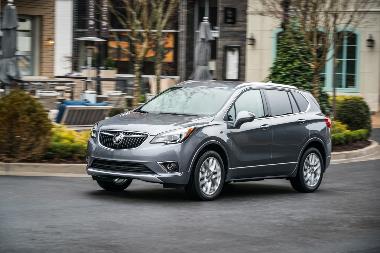
2019 Buick Envision: Midsize Crossover Gains Freshening to Attract American Buyers
Thursday, Feb 7, 2019
Back in the day, major automakers would build and sell the majority of their vehicles in America, with a smattering of sales overseas. That is no long …Back in the day, major automakers would build and sell the majority of their vehicles in America, with a smattering of sales overseas. That is no longer true for all vehicles. Case in point: the Buick Envision, a midsize crossover that was built and FIRST sold in China in 2014, and didn’t come to the U.S. until 2016. Last year. Buick sold 40,000 Envisions in America, and 236,000 in China.Show More
With more American sales in mind, and still only three years into its first American generation, Envision has undergone a big-time freshening for 2019. With new design, performance and tech features, the semi-luxury sports-ute features new sculpted front and rear fascias and new grille design; lighting upgrades across all trims; new LED taillamps; new 18- and 19-inch wheel designs; engine stop/start deactivation switch — a Buick-first in North America; single-rate brake booster for improved overall brake performance that requires less effort; flexibility to switch between Adaptive Cruise Control and conventional Cruise Control; enhanced visibility on Rear Vision Camera; improved hands-free microphone for better call quality and better voice recognition; a quicker-warming seat heating system; and a new exterior color: Satin Steel Gray Metallic.
From a power perspective, the 2019 Envision gains increased vehicle performance of 252 horsepower and 295 lb.-ft. of torque with the 2.0-liter turbo engine matched to a 9-speed automatic transmission for quicker acceleration.
In connectivity, the freshening includes next-generation wireless charging with wattage capability for fast and efficient charging including iPhone8/iPhoneX compatibility; and for driver and passenger peace of mind, the cabin also gets an in-vehicle air ionizer that helps eliminate odors, reduce bacteria and provide better air quality.
With a luxury look, Envision comes at you with its sculpted exterior and new winged-tri-shield grille that align with the new face of Buick. Crisp horizontal lines on the front create a more premium look and feel, while redesigned taillamps, reflectors and side markers give the back end a wider and more athletic stance. New optional 19-inch wheels provide an expressive and distinct profile and there are LED wing signature lights on every model. Sizewise, Envision fills the gap between the small Encore and large Enclave and measures 183.7 inches long, 72.4 inches wide and 66.8 inches high on a 108.3-inch wheelbase, and has curbweight of 3755 for FWD and 4083 for the loaded AWD models.
Inside, the changes are thoughtful and driver oriented. Interior design and materials are enhanced and worthy of the entry-level luxury car niche. Premium lighting technology is featured on every 2019 Envision. HID headlamps with LED Buick signature lighting come standard, with the enhanced performance of bi-functional LED headlamps standard on the top two trims. The seats are comfortable, supportive and well-cushioned; the cabin is Buick-quiet on the highway, and the suspension makes for a smooth highway ride. Visibility is good up front, but sightlines in the rear are slightly obstructed by the roof shoulders. Roomy for the segment, the Envision cabin affords 40 inches of front headroom with 38.5 in row tow; legroom is 40.9 and 37.5; and shoulder room is measured at 57 inches up front and 55.8 in the rear
Envision offers two engine choices: The 2.5-liter 1-4 is rated at 197hp and 192 lb-ft of torque, and gets 29 highway and 22/city; and the 2.0-liter turbo is good for 252 hp and 295 lb-ft and is EPA-rated at 25mph/highway and 20mpg/city. I drove the turbo and averaged 20.3mpg on wintry roads.
Acceleration is predictable and responsive, and in track tests, I managed a zero-to-60mph sprint in 6.8 seconds during a 15.4-second quarter-mile. Handling was niche-expected, with slight top wobble during S-curves, and some sway and understeer during quick maneuvers.
Attending to safety, the Envision provides 10 standard air bags, including side-curtain and knee air bags; standard rear-vision camera with Rear Park Assist; tire fill alert and standard safety-belt pretensioners and load-limiters. The Premium trims also get standard Safety Alert Seat; Forward Collision Alert and Following Distance Indicator; Side Blind Zone Alert with Lane Change Alert; Lane Keep Assist with Lane Departure Warning and Rear Cross Traffic Alert. The Driver Confidence Package is available on Premium II and includes Adaptive Cruise Control, Surround Vision and Front Automatic Braking.
The 2019 Buick Envision starts at $33,190 for the 1SV trim; $34,695 for the Preferred model that adds a Hands-Free Power Liftgate, Rear Park Assist, Rear Vision Camera and Smartphone Connectivity; $36,995 for the Essence trim with Rear Cross Traffic Alert, Perforated Leather-Appointed Seating, Heated, Leather-Wrapped Steering Wheel and Heated Rear Outboard Seating; $41,895 for the Premium trim I tested, that added the 2.0L Turbo engine, Forward Collision Alert, Lane Keep Assist w/Lane Departure Warning and Bose® Premium 7-Speaker System. The top trim is the Premium II for $44,795, with Automatic Parking Assist, Buick Infotainment with Navigation, Heated and Cooled Front Seats and Head-Up Display. My Premium trim Envision in AWD added Galaxy Silver Metallic paint for $495 and was mated to an Ebony, perforated leather interior; the Road Trip Package with all-weather floor mats and roof rack rails added $370; a Panoramic Power Moonroof added $1495; front and rear splash guards added $270; body-color molded assist steps added $790; and destination and freight was $1195. Local discounts were $2000 when I inquired, so check with your dealer, but my sticker came in at $42,945.
Visit www.CarlisleEvents.com for more on the automotive hobby.
Mike Blake, former editor of KIT CAR magazine, joined Carlisle Events as senior automotive journalist in 2004. He's been a "car guy" since the 1960s and has been writing professionally for about 30 years.
-
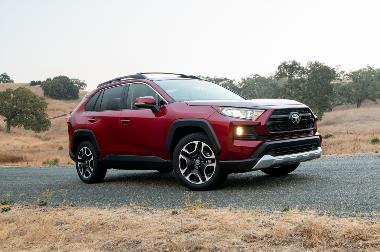
2019 Toyota RAV4: Shattering Perceptions of the Small SUV
Thursday, Jan 31, 2019
The original Toyota RAV4 arrived in the United States 22 years ago, casting the mold for a new industry segment, which evolved into the compact cro …
Show MoreThe original Toyota RAV4 arrived in the United States 22 years ago, casting the mold for a new industry segment, which evolved into the compact crossover SUV. The hip, sporty, small crossover was named for being a “Recreational Active Vehicle with 4-wheel drive” (RAV4), although not all RAV4s have four wheel drive.
Popular from the beginning and garnering 408,000 vehicle sales in the U.S. last year, RAV4’s detractors have said it was too small, too slow and not inspiring. Taking that to heart, the 2019 RAV4 has been re-imagined for its 5th generation and is being marketed as a perception shift. Keying on that in Toyota’s Super Bowl commercial, the ad focuses on 22-year-old (get the 22-year symbolism) Antoinette “Toni” Harris, a sophomore defensive back at East Los Angeles College. Harris is the first female football player to play a non-specialist position, and was the first woman to be offered a full scholarship as a non-specialist on defense. The key lines are: “They said she was too small … too slow …too weak. They said she would never get to the next level … never inspire a new generation. People have made a lot of assumptions …” Harris says: “I have never been a fan of assumptions.” And neither is Toyota, who says, “Let’s go places,” as they bring RAV4 to the next level.
To that end, the 2019 Toyota RAV4 gets a major update with a new look, a new chassis and upgraded standard connectivity and safety technology. Larger and sitting higher with greater ground clearance, the all-new RAV4 loses a bit of the old sportiness in favor of a rounded and bold SUV look, with a prominent grille, flat nose, brawny shoulders and sculpted character lines. Inside, the interior design of the 2019 RAV4 has a more premium look and feel compared to the 2018 version. Like the exterior, the look of the interior can change quite a bit based on your trim of choice. For example, the Adventure grade has a more rugged interior with orange trim, while the Limited model has a more premium, upscale interior.
Available in naturally aspirated and hybrid models, the new design is based on Toyota’s new Global Architecture platform for a solid foundation and improved driving dynamics, comfort, and safety. The all-new RAV4 keeps its compact dimensions with a 105.9-inch wheelbase (a gain of 1.2 inches over last-Gen), and a length of 180.9 inches (down 0.2 inches). Height gains 1.3 inches at 67.2 for my test model, while width is 0.4 inches wider at 73.0 Ground clearance has gained a soft-road worthy 2.3 inches to 8.4 inches, and RAV4 has lost about 100 pounds to a range of 3380 to 3490 pounds depending on trim.
Musclewise, non-hybrid RAV4 grades are powered by an efficient 2.5-liter Dynamic Force 4-cylinder engine that delivers 203 hp and 184 lb-ft of torque, a gain of 27 horses and 12 lb-ft over last year. The AWD version is rated at 25mpg/city and 33mpg/hwy. The RAV4 Hybrid is also powered by a 2.5, assisted with an electric motor on the rear axle. The combined system output is 219 hp, and 400 lb-ft, and backed by an electronically controlled continuously variable transmission, is rated at 41/37 with a combined average of 39mpg. My naturally aspirated test ride achieved an average of 29.7mpg in mixed-use town, highway and softroad driving in wintry conditions. RAV4 has always been favored as a pavement ride, but it can handle soft-road diligently and light off-road well.
In track tests on non-groomed pavement, not the best for timing trials, my RAV4 managed an 8-second-flat zero-to-60 run and a 16.2-second quarter-mile. The compact was attentive, steered well for the niche, exhibited only slight sway and top-wobble during quick-turning, and while noisy (engine noise) inside, offered a supple ride.
The RAV4 cabin is sporty and accommodating and filled with infotainment including a 6-speaker Entune™ Audio system with 6.1-inch touchscreen. Front headroom is a bit tight, but expected for the niche, at 39.5 inches (0.3 inches less than last year), with 39.5 also in row two (a gain of 0.6). Legroom is accommodating at 41.0 inches in row one (though a loss of 1.6 inches) with 37.8 inches (up 0.6) for second-seat passengers and there is a wide-body 57.8 inches of shoulder room in front (up 0.5) with an inch more room in this year’s row two, at 56.4 inches.
From a safety perspective, RAV4 is on point with the Toyota Safety Sense™ 2.0 Pre-Collision System with Pedestrian Detection, which includes pedestrian detection, Lane Departure Alert, Dynamic Radar Cruise Control, Road Sign Assist, Lane Tracing Assist and Steering Assist. RAV4 also has Star Safety System™ with Traction Control, Electronic Brake-force Distribution, Enhanced Vehicle Stability Control, Brake Assist, Anti-lock Braking System and Smart Stop Technology. Eight standard airbags consist of dual stage advanced driver and front passenger airbags; front seat-mounted side airbags; first and second row side curtain airbags; driver’s knee airbag and a front passenger seat cushion airbag.
The base RAV4 Hybrid starts at $27,385 plus a delivery fee of $930, and the RAV4 LE bases at $25,500, with the XLE at $27,300, the XLE Premium at $29,500, the sporty Adventure at $32,900 and the Limited at $33,500, loaded with standard tech, safety and cosmetics. My test RAV4 Limited added Dynamic Torque Vectoring AWD for $1400; Ruby Flare Pearl (Deep Red) paint for $395 (mated to a Black Softex interior at no extra charge); Entune™ 3.0 premium audio with Dynamic Navigation added $580; all-weather floor and cargo liners added $169; mudguards added $129; a running board added $549; roof rack cross bars added $315; and delivery, processing and handling added $1095 for a sticker-as-tested of $38,232.
Visit www.CarlisleEvents.com for more on the automotive hobby.
Mike Blake, former editor of KIT CAR magazine, joined Carlisle Events as senior automotive journalist in 2004. He's been a "car guy" since the 1960s and has been writing professionally for about 30 years.
-
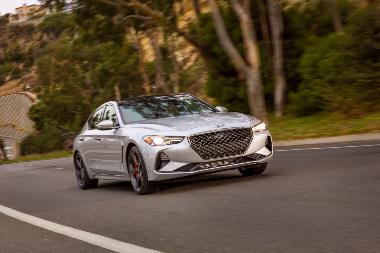
2019 Genesis G70: Luxury Brand Branches out with New 4-Door Compact Executive Performance Sedan
Thursday, Jan 31, 2019
In 2004, Hyundai chose to expand from the “econocar” ranks and enter the luxury market with Genesis, which was promoted as the first chapter of pre …
Show MoreIn 2004, Hyundai chose to expand from the “econocar” ranks and enter the luxury market with Genesis, which was promoted as the first chapter of premium cars to be manufactured by the South Korean, multinational automaker. Since its launch for the 2009 model year, Genesis was accepted as a luxury vehicle without a luxury price and without a hyped luxury nameplate. In 2017, Hyundai spun off its Genesis line as its own luxury-car badge, and for 2019, Genesis launches G70, Genesis Motors’ third model, a 4-door compact executive luxury performance sedan. And from the get-go, G70 has reaped awards and positive buzz.
The 2019 Genesis G70 has already been named: “The 2019 North American Car of the Year” by a jury of industry experts at the Detroit Auto Show; “2019 Car of the Year,” by Canada-based AutoGuide.com; “2019 GOOD DESIGN®” by The Chicago Athenaeum Museum of Architecture and Design; and it also received a “Top Safety Pick+” rating by The Insurance Institute for Highway Safety (IIHS).
Designed and engineered to offer driver-focused performance, refined luxury, advanced technology, and a world-class ownership experience, Manfred Fitzgerald, former Director of Brand and Design at Lamborghini, and now Global Head of the Genesis brand said, “The G70 is all about the driver’s experience. We look forward to how our youngest and most dynamic sedan will connect with our clientele through refined performance and athletic elegant design.”
G70 rounds out the Genesis brand’s sedan lineup, joining the G80, G80 Sport, and its flagship G90, and the brand will continue to expand its product portfolio to all echelons of the luxury auto market. Packed with interior tech and comfort, and exterior grace, G70 comes with a choice of powerful and refined turbocharged engines: 2.0-liter inline four-cylinder or a 3.3-liter V-6; available driver-focused features including Genesis Active Safety Control, limited-slip differential, Michelin® Pilot® Sport 4S tires and Brembo® brakes; available 6-speed manual gearbox (2.0T RWD model); and Genesis Connected Services that provide advanced telematics with seamless connectivity directly into the vehicle, with technology that includes Destination Search powered by Voice, Car Finder, Enhanced Roadside Assistance, and Stolen Vehicle Recovery. With a complimentary three-year subscription, Genesis Connected Services further enhances peace of mind for drivers and passengers, with SOS Emergency & Automatic Collision Notification.
Design wise, the G70 represents the future direction of the Genesis brand’s “Athletic Elegance” design signature. Its long hood and short overhangs, dynamic roofline, and high beltline characterize a sleek profile. In the side view, the parabolic character line displays kinetic form language with voluptuous curves and smooth surfaces. Like its sedan stablemates, the G70 features the Genesis Crest Grille with distinctive linear LED daytime-running lights. Built on the same platform that houses the Kia Stinger, but with a wheelbase that’s 2.8 inches shorter than its hatchback cousin, G70 measures 184.5 inches long, 72.8 inches wide and 55.1 inches high on a 111.6-inch wheelbase, and weighs in with a curbweight of 3847 lbs.
Inside, the G70’s interior delivers a driver-focused experience with high quality materials and unparalleled attention to detail. Genesis designers specified genuine brushed aluminum surfaces, quilted Nappa leather seats, stainless steel speaker grilles, and premium stitched soft-touch surfaces throughout the interior. An optional 15-speaker Lexicon high-fidelity audio system with QuantumLogic® surround-processing technology transforms any audio source into a rich and immersive listening experience.
The G70 cabin is well-appointed, but a bit cramped, and the rear seats accommodate two passengers more comfortably than three. Front headroom is a bit tight if you are over six-feet tall, at 39.7 inches, while legroom is roomy at 42.6 and shoulder room is 56.3. Rear accommodations are even tighter with head room of 36.9 inches, legroom is 34.8 and rear shoulder room is 54.6.
G70 is available with three powertrain configurations and five trim packages, and a choice of two engines: a 252hp/260 lb-ft torque, 2.0-liter turbocharged inline four-cylinder (22mpg/city and 30mpg/highway), and a 365hp/376 lb-ft 3.3-liter twin-turbocharged V-6 (18mpg/city and 25mpg/highway). I averaged 19.6mpg in my 3.3.
The manufacturer says the Genesis 3.3 will run a 4.5-second zero-to-60mpg sprint, and my test Genesis, tuned as one you would get from a dealership, managed a 4.9-second sprint and a 13.5-second (hand-timed) quarter-mile. And on the highway and around town, Genesis delivered a stable ride with solid balance and attentive handling. Rough winter roads were felt in the seats, and steering was vague at times, while tire noise did enter the cabin a bit, but G70 offered power when asked, and long interstate drives were fun and indulgent.
The 2019 Genesis G70 3.8 starts at $34,900 with the 2.0-liter engine in RWD and $36,900 in AWD. The 3.3-liter twin turbo model starts at $43,750 in RWD and $45,750 in AWD as was my test ride. In Santiago Silver, with a Black-Gray interior, my review vehicle added the 3.3T Prestige Package for $4250, with Heads-up Display, Surround View Monitor, Nappa leather seating surfaces with luxury quilting, heated rear seats, Microfiber suede headline, Low Beam Assist, Rain-sensing wipers, Parking Distance Warning, Wide sunroof and Wireless charging pad. Mud/splash guards added $60, and a clear vinyl rear bumper appliqué added $70, for a sticker of $51,125.
Visit www.CarlisleEvents.com for more on the automotive hobby.
Mike Blake, former editor of KIT CAR magazine, joined Carlisle Events as senior automotive journalist in 2004. He's been a "car guy" since the 1960s and has been writing professionally for about 30 years.
-
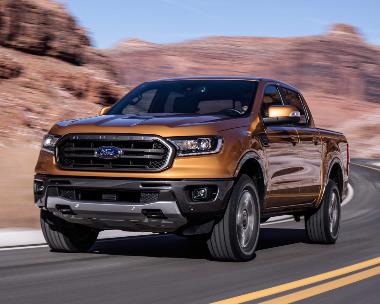
2019 Ford Ranger: Midsize Pickup is Back and it’s Tough, Sporty and Versatile
Wednesday, Jan 16, 2019
Pickup truck sales continue to increase – expected to exceed 2.8 million in US sales this year – and the midsize truck segment went over half-a-mil …
Show MorePickup truck sales continue to increase – expected to exceed 2.8 million in US sales this year – and the midsize truck segment went over half-a-million last year, so Ford, the perennial truck-selling champ, has re-entered the midsize segment competition by bringing back Ranger. After an eight-year hiatus, the Ford Ranger is back and touted by Ford as “most fuel-efficient gas-powered midsize pickup in America.”
Ford’s Ranger began its truck life in 1965 as a Ford F-Series trim package, and became its own compact pick-up line in 1983, replacing the Ford Courier. The compact Ranger ceased production in 2011 for the U.S. and Canada, but began globally as an international mid-size pickup. Well, Ranger is back in the US as a versatile midsize -- it can be configured with several cab and bed sizes, to 2x4, 4x4, and with off-road, in-town or hauling-load capabilities.
The old Ranger was a small, rather pedestrian truck. The new Ranger is larger, tech savvy, infotainment rich, upscale and ruggedly sporty, with workhorse attributes. Ranger is all-new and all-modern, inside and out. Its body-on-frame construction (an all-steel frame and steel bumpers) is sculpted into a muscular body with a high beltline, raked grille and windshield to increase aerodynamics and reduce wind noise while taking on an athletic demeanor; and short overhangs mean better approach and departure angles and improved off-road capability.
Available in three trim levels (X, XLT and Lariat) in either rear-wheel-drive or 4x4, Ford Ranger is assembled at the Michigan Assembly plant in Wayne, Michigan. With a 126.8-inch wheelbase, 210.8-inch length 85.8-inch width and height ranging from 70.7 to 71.5-inches depending on configuration, Ranger has a running ground clearance of 8.4 to 8.9 inches (depending on configuration) and curb weights of 4145 to 4441 lbs. Towing capacity maxes out at 7,500 pounds, and its payload is rated at 1,860.
Ranger has not spared the muscle … especially for a mid-size. While a 335-hp Ranger Raptor may be available in 2020, the 2019 Ranger shows plenty of brawn. Powered by an aluminum 2.3-liter EcoBoost® I-4 with Auto Start-Stop, mated to a 10-speed SelectShift® automatic, the system puts out 270hp and 310 lb-ft of torque, for an EPA-estimated fuel economy rating of 21 mpg city, 26 mpg highway and 23 mpg combined. My week of winter-condition testing realized an average of 23.3mpg.
With little turbo lag, my heavily feature-filled test Ranger smoked the pavement to a 7.2-second zero-to-60 sprint during a 15.6-second (hand-timed) quarter-mile. Uphill grades were conquered easily and passing at speed is no prob. Steering is more carlike than trucklike, and while you do get sway during high-speed or autocross maneuvers, feedback is good for the segment. That helps translate into a gentle driving and passenger experience, as the short- and long-arm independent front suspension with tubular stabilizer bar works well with the Hotchkiss-type non-independent rear with live, leaf springs and outboard shock absorbers to smooth out pavement irregularities, while allowing for off-road feel and success on odd terrain.
Interior space is supple with front headroom of 39.8 inches, front legroom of 43.1 and front shoulder room of 56.6. With seating for five, rear measurements are headroom: 35.9, legroom: 30.4 and shoulder room: 55.3. Quiet inside, Ranger is refined, with little road noise, no squeaks, rattles or typical truck noises; and a host of niceties. The cabin is equipped with dual zone air conditioning, SYNC® 3, infotainment, Android Auto, Apple CarPlay, 8-inch touch screen, power windows and mirrors, and heated seats.
Safetywise, Ranger utilizes standard Pre-Collision Assist with Automatic Emergency Braking; a Lane-Keeping System that includes lane-keeping assist, lane-departure warning and reverse sensing; and class-exclusive Blind Spot Information System with trailer coverage; all standard on XLT and Lariat. Adaptive Cruise Control is standard on Lariat. Ranger is also outfitted with dual-stage driver and right-front passenger front airbags; front-seat side airbags and a Safety Canopy® System with side-curtain airbags and rollover sensor. You also get Automatic Emergency Braking, Anti-Lock Brake System, rear view camera, Remote Keyless Entry with remote tailgate lock, SecuriLock® Passive Anti-Theft System, SOS Post-Crash Alert System™, Tire Pressure Monitoring System and trailer sway control.
The 2019 Ford Ranger starts at $24,300 for the base XL with SuperCab, 6-foot box and 4x2. The XLT starts at $27,940 and the upscale Lariat starts at $32,210. My test XLT went to the Super Crew Cab and 5-foot-box for an extra $2175. I need 4x4 drive stability and upgraded from 4x2 for an additional $4000. My Ranger was covered in Saber (Burnt Orange) paint as part of the $1790 301A package that added an auto-dimming rearview mirror, leather-wrapped steering wheel and shifter, folding sideview mirrors with power glass, and SiriusXM® Satellite Radio, SYNC® 3. Package 302A was also added for $2800 – we got 8-way power driver and passenger heated seats with power lumbar, manual sliding rear window, remote start and a Sport Appearance Package with lots of cool cosmetics. The bed utility package with bedliner added $395, and the $795 Technology Package added a number of technology features including navigation and Adaptive Cruise Control. Front and rear splash guards were $130, and destination charges were $1195, for a sticker-as-tested of $39,430.
Visit www.CarlisleEvents.com for more on the automotive hobby.
Mike Blake, former editor of KIT CAR magazine, joined Carlisle Events as senior automotive journalist in 2004. He's been a "car guy" since the 1960s and has been writing professionally for about 30 years.
-
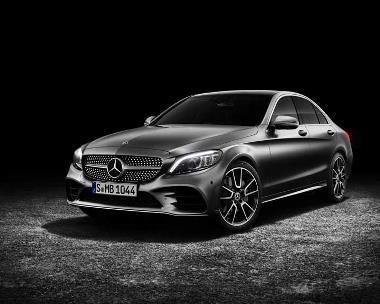
2019 Mercedes-Benz C300: Refreshened with Fluid Design and Added Power and Tech
Wednesday, Jan 9, 2019
Mercedes-Benz is on the move with new designs, enhanced interiors and exteriors. Going with creaseless, smooth architecture and luxurious cabins wi …
Show MoreMercedes-Benz is on the move with new designs, enhanced interiors and exteriors. Going with creaseless, smooth architecture and luxurious cabins with infotainment centers, Mercedes-Benz is refreshening this year. The manufacturer touts the tweaks as “combining emotion with intelligence.”
Among the refreshed lines is the 2019 C-Class Sedan also enhanced with increased power and extended driver assistance systems. Among the highlights are a redesigned front end, newly designed LED headlamps and taillamps, a new, more powerful, and efficient engine that increases output by 14 horsepower, and the extended suite of Intelligent Drive features shared with the Mercedes-Benz E.
Introduced in 1993 as a replacement for the M-B 190, the C-Class was the smallest (at the time) class in the Mercedes-Benz arsenal, and it is currently Mercedes-Benz's top-selling model.
Exterior changes for this year include redesigned front and rear bumpers, and the vehicle equipped with AMG-Line features, get a diamond radiator grille as standard. The front bumper presents a chrome-plated trim as part of the standard vehicle. The rear bumper on the Sedan has a new lower section – its geometry, trim and tailpipe trim vary according to the selected equipment. And you get power-folding side mirrors.
The design of the headlamps and taillamps is defined by clear-lined contours. Exquisitely crafted details add highlights and underscore the C’s modern character, and the C-Class is now equipped with LED headlamps and taillamps as standard. An LED Intelligent Light System with High Performance headlamps and ULTRA WIDE high beam is optionally available.
With steel unibody, aluminum outer sheet metal construction, the C300 measures 184.5 inches long, 71.3 inches wide and 55.3 inches high on a 111.8-inch wheelbase. Ground clearance is 3.5 inches, and we scraped a few times during tests.
The sporty interior is elegant, featuring flowing forms in a new interpretation of modern luxury. The center console is characterized by an elegant graceful trim, now available in Natural Grain Walnut Wood or Natural Grain Grey Oak Wood. The 3D real wood veneer in the center console combines a hand-crafted character with a modern feel. Magma Grey/Black upholstery is newly available for the interior, as is Saddle Brown and Silk Beige/Black for the AMG-Line Interior. The KEYLESS START function is standard and the start/stop button comes in a new turbine-look design. The vehicle key also features a new design.
Inside, C300 offers 44.0 inches of front legroom, but only 26.0 inches in row two. Shoulder room is 54.8 in front and 51.7 inches in row two, But those confines are packed with such standard items as power front seats with driver-seat memory, power tilt/sliding tinted glass sunroof, dual-zone automatic climate control, 40/20/40 split-folding rear seats, SmartKey, analog gauges with high-resolution multifunction display, 7-inch high-resolution central display, 3-spoke steering wheel with Touch Control Buttons, central controller, Bluetooth audio streaming, dual USB audio ports, HD Radio receiver, FrontBass® system, Apple CarPlay and Android Auto.
Gaining 14hp over last year, the C300, C300 4MATIC both come with 255hp in-line 4-cylinder engines, and the 385hp V-6-powers AMG C43 trim. Torque estimates are 273 lb-ft for the 2.0-liter in-line 4 and 384 lb-ft for the 3.0-liter V-6.
My 2.0-liter was matched to a 9G-TRONIC 9-speed automatic transmission and was rated at 22mpg/city, 31mpg/highway and 25mpg combined. My tests yielded an average of 24.6mpg.
Given a factory estimate of 5.9 seconds for a zero-to-60 sprint (the 3.0-liter V-6 is manufacturer-estimated at 4.5 seconds), inclement weather canceled track tests, but last year’s tests with the smaller-hp engine (241 hp) showed 6.8 seconds and a 15.2- quarter-mile, and this year’s more powerful (by 14hp) engine seemed quicker and accelerated smoothly. Power was always there when called upon.
From a safety perspective, C300 pays attention with front-impact airbags, side impact airbags, overhead airbags, knee airbags, seatbelt pretensioners , anti-whiplash head restraints, anti-lock brakes, stability control and a security system that has a means of anticipating and/or detecting unwanted vehicle intrusion. The vehicle is equipped with an ignition disable device that will prevent the engine from starting if the correct original manufacturer key is not used.
The 2019 Mercedes Benz C300 sedan bases at $41,400 in Black or Polar White – other colors will cost extra. My test ride was bathed in Selenite Metallic (dark gray) for an extra $720. AMG styling starts at $2000 extra, but mine was a base C300. The Exterior Lighting package adds Intelligent Light System with Ultra Wide Beam headlamps and Adaptive Highbeam Assist for $900. A rear spoiler added $300; cool LED logo light projectors added $200; Magma Grey leather upholstery in the Leather Seating Package with Memory for front passenger seat added $1950; Heated front seats were $580; Heated Steering Wheel was $250; the Multimedia Package with COMMAND navigation, touchpad controller, enhanced voice control, Car-to-X Communication and a 10.25-inch high-resolution center display added $2600; a panorama roof added $1000, inductive wireless charging and NFC pairing added $170, and the $2250 Driver Assistance Package added active distance, steering and evasive steering assist, brake and cross traffic assist, emergency stop, speed limit, blind spot and lane change assist, for a sticker-as-tested of $51,930.
Visit www.CarlisleEvents.com for more on the automotive hobby.
Mike Blake, former editor of KIT CAR magazine, joined Carlisle Events as senior automotive journalist in 2004. He's been a "car guy" since the 1960s and has been writing professionally for about 30 years.
-
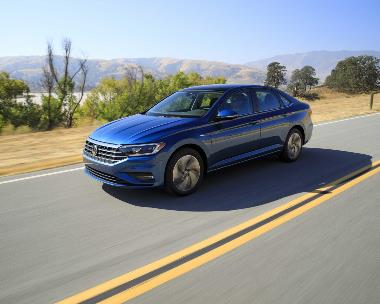
2019 Volkswagen Jetta 1.4T: Fun to Drive, Larger and More Coupelike
Wednesday, Jan 2, 2019
We begin our coverage of 2019 models with the new, seventh-generation 2019 Volkswagen Jetta. VW’s best-selling car was once offered in sedan and ha …
Show MoreWe begin our coverage of 2019 models with the new, seventh-generation 2019 Volkswagen Jetta. VW’s best-selling car was once offered in sedan and hatchback configurations, but is now only presented as a sedan.
For the 2019 model year, the Jetta is based on Volkswagen’s Modular Transverse Matrix (MQB) platform architecture. Working with the flexible MQB platform allowed the designers to reshape the body, creating a longer wheelbase, wider track, and a shorter front overhang. The fast-sloping rear roofline translates into a coupe-like profile. Dynamic lines and taut surfaces combine with the new silhouette to give Jetta a look that is elegant, yet athletic.
Compared with the outgoing generation, Jetta grows outside in every direction. It is longer, wider and taller than the outgoing model. The increased exterior proportions add up to more interior space than the previous car as well. While larger than earlier editions, Jetta is still compact at 185.1 inches long (1.8 inches longer), 70.8 inches wide (an increase of 0.8 inches) and 57.4 inches high (0.2 inches higher) on a 105.7-inch wheelbase (a gain of 1.3 inches), with a ground clearance of 5.8 inches (up 0.6 inches). Jetta seats five and weighs in at a light 2970 lbs, 220 lbs lighter than before, for the automatic transmission version.
The new front end design, with its emphasis of horizontal lines still identifies with VW. Specific to the model is the distinctive unit formed by the radiator grille and the standard LED headlights. The trapezoidal grille is composed of four chrome bars, two of which flow into the headlight housings where the LEDs pick up the lines and connect them for a wrap-around effect.
The car's silhouette is marked by its taut surfaces and a long, extended side window. The coupe-like impression of Jetta is reinforced by an offset roofline known as a 'phase'—a narrow strip that runs parallel to the actual roofline and into the C-pillar—which visually reduces the car's height.
Jetta’s upscale driver-centric interior architecture has been redesigned, having been engineered for increased comfort while supporting a sophisticated, upscale design. The 2019 Jetta has more headroom, knee room, and shoulder room than the previous car, and both the instruments and the infotainment system are arranged in an easy-to-read horizontal orientation.
The cabin is accommodating with an un-compactlike at 38.5 inches of front headroom (a gain of 0.3), with 37.2 inches in row two (up 0.1); shoulder room is 55.9 inches in front (0.7 inches more than last year) and 54.0 inches in the rear (up 0.4); while legroom is marginally tighter, but still a comfortable 41.1 inches for row one and 37.4 inches for the second-seat passengers. Trunk room has shrunk from16 cu.ft. to 1 cu.ft.
Fun to drive, Jetta’s 1.4T is powered by the base 1.4-liter inline four-cylinder turbocharged/intercooled engine that provides 147hp and 184 lbs.-ft. of torque. A 2.0-liter 220hp turbo engine will be available in the GLI trim for 2020.
Both the six-speed manual and the eight-speed automatic versions are rated well with the automatic EPA-rated at 30mpg/city, 39mpg/highway and 34/combined for the 1.4. The manual tops at 40mpg highway. My week of tests in the automatic averaged 33.3mpg.
My automatic SEL Premium trim accelerated and turbo’d-in seamlessly, and delivered solid acceleration off the line. Speed increase was predictable and reliable when needed, and rack tests showed a 7.6-second zero-to-60mph sprint and a 16-second quarter-mile.
My Jetta handled consistently, but quick acceleration and turns resulted in severe body lean. The rack-and-pinion, electric steering with power assist was a bit vague, but all in all, in varied tests, Jetta was balanced and responsive for the niche.
Building on its rep as a top safety vehicle, the 2019 Jetta offers a combination of both passive and active safety systems that are engineered to meet or exceed current crash regulations. And Jetta’s MQB chassis is a much more rigid architecture than the previous version, which pays dividends in safety for both passengers and pedestrians alike. Highlights include a rigid laser-seam-welded bodyshell, crash-optimized, energy-absorbing front end, and heat-formed steel center B-pillars.
The base 2019 Jetta S 1.4T starts at $18,545, followed by the 1.4T SE at $22,155 (adding a Panoramic sunroof and keyless push-button start); the R-Line at $22,995 with special alloy wheels and two-tone leatherette seating; the SEL at $24,415 with 10-color interior ambient lighting, BeatsAudio® and VW Digital cockpit added; and the SEL Premium starting at $26,945 with metallic alloy wheels and premium finish, 8-inch touchscreen navigation, leather seating surfaces and ventilated front seats.
My test Jetta SEL Premium was bathed in Silk Blue Metallic exterior paint, mated to a Titan Black Leather interior. I prefer a manual transmission in sports cars, but my test ride was outfitted with an 8-speed automatic with Tiptronic® and Sport mode as standard for the trim level. Monster Mats® (great for mud and winter weather) added $105; and MuddyBuddy® trunk liner added $105. Side window deflectors added $135; splash guards added $116; Auto-dimming mirror with HomeLink® added $285; Bumperdillo® rear bumper protector added $110; and destination charges added $895, for a sticker-as-tested of $28,696, to start 2019 under $30K.
Visit www.CarlisleEvents.com for more on the automotive hobby.
Mike Blake, former editor of KIT CAR magazine, joined Carlisle Events as senior automotive journalist in 2004. He's been a "car guy" since the 1960s and has been writing professionally for about 30 years.
-
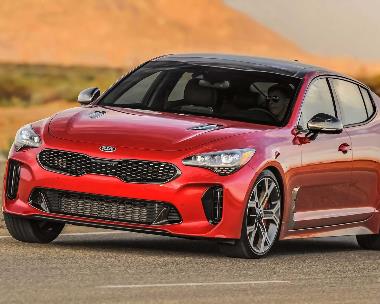
2018 Car of the Year: Kia Stinger: New Sports Sedan is Powerful and Luxurious
Wednesday, Dec 26, 2018
Last week, our “Car Buy of the Year,” Top-10 list focused on the “best bang for the buck,” with the 2018 Hyundai Kona winning top honors. This week …
Show MoreLast week, our “Car Buy of the Year,” Top-10 list focused on the “best bang for the buck,” with the 2018 Hyundai Kona winning top honors. This week, we present our “Car of the Year” list, in which we concentrate on the best car, truck, crossover or SUV and what it delivers, regardless of price – just the pure vehicle – and how it feels to be behind the wheel.
For our 14th annual Car of the Year list, we see new models, sports-luxury cars, iconically badged SUVs, legendary sports cars, nostalgic muscle cars, Eurocars, sporty sedans, a luxury sedan and even an econo-compact SUV.
My rules: To make this list, I must have test driven the car in calendar 2018 and it must have stood out from the pack, surprised me, impressed me, and satisfied the “car guy” in me, as well as amaze any passengers or onlookers who rode in or saw the vehicle.
I test drove 54 different vehicles this year, and after a weeklong (in most cases) assessment as a daily driver and/or track car, I graded each ride in the following categories: Interior; Safety; Power; Handling/Ride; Economy/Price; Looks; Niche-fitting and a Miscellaneous grouping in which I took into consideration the “feel-good” factor and other intangibles. Each category had its own integrity and encompassed such items as driver intuitiveness, comfort, easy-to-read instrumentation, quietness and ease of surroundings. In each category I award from zero to 10 points (10 being perfect)..
Last year, a Lexus LC 500 luxury Coupe won the title, and this year, an all-new mid-size luxury sedan from a traditionally non-luxury badge combined elegance and power, performance and grace to take the crown. Prices reflect sticker-as-tested.
No. 1 Kia Stinger: Dynamic new sports car combines athleticism and luxury -- $53,255
Kia has come a long way, and with the all-new 2018 Kia Stinger, the manufacturer has entered the mid-size luxury four-door sports car segment debuting an athletic, bold, adventurous performance car with luxurious accommodations. From its sleek front clip through its graceful sides and slender shoulders, Stinger exudes a muscular confidence. Inside, Stinger exudes an aircraft-like feel filled with upscale accouterments. It is powered by a 3.3-liter twin-turbo V-6 with 365 hp and 376 lbs-ft. and it blazed a 4.7-second zero-to-60mph dash and a 13.2-second quarter-mile. My test Stinger GT2 averaged 22.0mpg in mixed-use driving, and exhibited solid sportscar exuberance, acceleration and handling.
No. 2 Jaguar E-Pace: Compact luxury SUV with the look and feel of a ‘Cat -- $55,110
An all-new compact-luxury crossover with a Catlike look indicative of its Jaguar DNA, E-Pace packs the design and performance of a Jaguar sports car into a practical and connected all-wheel-drive vehicle with SUV practicality. E-Pace features a four-cylinder Ingenium gasoline engine that delivers 296 hp and 295 lb-ft of torque. At the track, I zipped from zero-to-60mph in an impressive 6 seconds flat during a 14.5-second quarter-mile. My mixed-use tests averaged 23.3 mpg.
No. 3 Corvette Grand Sport: Blazing hot and super cool on highway or track -- $82,715
Finishing third for the second straight year, the Corvette Grand Sport borrows from Stingray design cues with a touch of Z06, including the front grille and wider rear fenders, which give it an aggressive stance and a wide track. High tech and luxurious inside, performance is key as the 6.2-liter V-8 roars out 460hp and 465 lb-ft of torque and rocketed to a 3.9-second zero-to-60mph sprint and 12.3-second quarter-mile. My tests averaged 16.3 mpg.
No. 4 2018 Chevrolet Camaro ZL1: Historically powerful, hot and fast -- $72,515
The most powerful Camaro ever, and highest hp on this list, my 2018 Camaro ZL1 and its 650 horses/650 lb-ft of torque blazed the dash in 3.4 seconds (hand-timed), and finished off a quarter-mile in 11.4 seconds. Traditional Camaro styling lives on with a muscular and sporty architecture, sculpted creases, a proud undergrille, a low and wide stance and enhanced interior packed with infotainment. Camaro’s structure and balance was race-car precise.
No. 5 Ford Mustang GT: More Pony Power and enhanced exterior and tech -- $45,875
Also last week’s No. 7 CAR BUY of the YEAR, the Ford Mustang GT has tweaked up with a sleek new design, more advanced tech and improved performance enhancements. The 5.0-liter V-8 provides 460hp and 420 lb-ft and can be mated to 10-speed transmission. On the highway, you have ground-hugging stickiness and cornering confidence. Muscular and attentive, I dashed from zero to 60mph in 4.7 seconds during a 13.3-second quarter-mile, and I averaged 18.2mpg in mixed-use tests.
No. 6 Volvo XC60: Full redesign, new safety suite for premium mid-sized SUV -- $52,070
Volvo XC60 has been completely redesigned for 2018. XC60 keys in on safety with Volvo’s ground-breaking City Safety system, and there’s enhanced driver infotainment, a new exterior and new CleanZone four-zone climate system that removes harmful pollutants and particles from outside to deliver fresh air on the inside. Its 2.0-liter 4-cylinder engine that provides 250hp and 258 lb-ft of torque got me 22.2 mpg and finished off a sprint in 6.9 seconds and a quarter-mile in 15.3.
No. 7 Toyota Camry: Midsize family sedan evolves with sportscar tendencies -- $38,017The all-new eighth-generation Toyota Camry is an established mid-size family sedan that has turned into a sports car … of sorts. Redesigned with a sporty and upscale image both inside and out, and longer, wider and closer to the ground for increased ride dynamics, its 3.5-liter engine is rated at 301hp and 267 lb-ft of torque. A zero-to-60mph dash was accomplished in a smooth 5.8 seconds during a 14.4-second quarter-mile. Fuelwise, I averaged 26.7mpg in mixed-use tests.
No. 8 Hyundai Kona: Sub-Compact CUV marketed to youthful driver-adventurers -- $29,805
The lowest-priced and lowest-hp vehicle on this week’s list was also last week’s No. 1 CAR BUY of the YEAR. Hyundai has targeted youthful “urban adventurers” with its all-new sub-compact crossover utility vehicle, the 2018 Hyundai Kona. With aggressive body styling, a sporty demeanor, top-of-the-line safety technology and advanced infotainment features in a compact footprint, Kona handles well and its 1.6-liter turbo generates 175 hp and 195 lb-ft of torque for an average of 26.7 mpg.
No. 9 Dodge Charger: America loves its muscle, then and now -- $41,500
Drawing on cues from the historic 1969 model, Dodge Charger is America’s only four-door muscle car and the sales leader in the large car segment for five years running. This year’s model gets new cosmetics, interior upgrades, wheel packages and colors on various models. The 5.7-liter HEMI V-8 that powered my R/T trim Charger stampedes out 370 horses and 395 lbs-ft of torque, averaged 22.2mpg and completed a zero-to-60mph sprint in 6 seconds during a 14.4-second quarter-mile.
No.10 Buick Regal GS: More powerful, sportier and upgraded cabin -- $44,255
Buick has gone all-new with Regal in 2018, with a sleek, sporty design increased horsepower, an upgraded cabin and advanced infotainment. Buick offers a sculptured Euro-sportiness with aggressive front and rear fascias, unique GS-specific cabin additions, and an aluminum 3.6-liter direct injection V- 6m rated at 310hp and 282 lb-ft of torque. My week of mixed-use tests yielded an average of 20.7mpg and my zero-to-60mph time was 5.5 seconds during a 14.5-second-flat quarter-mile.
Next week we begin coverage of the 2019s, and we start learning about next year’s best cars.
Visit www.CarlisleEvents.com for more on the automotive hobby.
Mike Blake, former editor of KIT CAR magazine, joined Carlisle Events as senior automotive journalist in 2004. He's been a "car guy" since the 1960s and has been writing professionally for about 30 years.
-
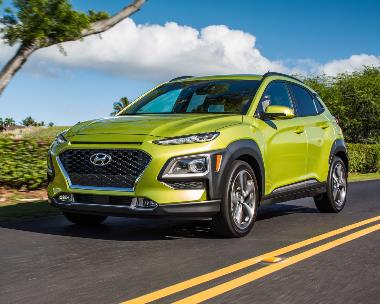
2018 Car Buy of the Year: Hyundai Kona: Urban-Smart Compact CUV
Wednesday, Dec 19, 2018
For the 14th consecutive year, we finish up the model year in ALL ABOUT CARS with a Top-10 list consisting of the vehicles we tested and reviewed t …
Show MoreFor the 14th consecutive year, we finish up the model year in ALL ABOUT CARS with a Top-10 list consisting of the vehicles we tested and reviewed this year; and after rating them, have concluded that they are the “best deals on wheels” in 2018. Next week, we will present our “vehicle of the year” regardless of price.
Now, just because a vehicle delivers the best bang for the buck, it doesn’t always translate into sales. In 2018, trucks were the top three-selling vehicles in the U.S., and no truck made my list this year. To make ALL ABOUT CARS’ “Car Buy of the Year” list, sales is not part of the equation. To be considered for this list, I must have test-driven the vehicle during calendar 2018, and dollar-for-value, or worth vs. cost carries the most weight, though some abstracts still apply.
Rated for this year’s competition, I test drove 54 vehicles, drove them, tested them and examined them for about a week each, using them as daily drivers around town for errands and for maneuvering; on the highway for long trips, for passing, stability and for fun; accelerating them and braking them hard on straight tracks and banked venues, auto-crosses and drag strips, and checking out what passengers and onlookers reported.
The cars tested vary from year to year. Some years we have higher-priced vehicles of great value on the list -- a low price is not always the sign of a great value. Price certainly is a factor; as is fuel economy, but the vehicle’s personality, how it fits its niche and how you feel driving it all play a part. This year, the winner was one of three finalists priced under $30,000 and eight of the 10 were under $40,000. Two cars on the list were priced in the $40,000 range.
The candidates were graded in eight categories, with vehicles earning 10 points for best possible to 1 point for worst possible. I gave only six perfect 10s in any category all year; no vehicle received less than a charitable 5 in any category, and no vehicle received more than a single category 10. My eight graded segments are: Interior; Safety; Power; Handling/Ride; Economy/Price; Looks; Niche-fitting and a Miscellaneous grouping in which I took into consideration the “feel-good” factor and other subjective intangibles
One more thing: the difference between this week’s Best Car Buy winner and next week’s “Car of the Year” champion is that this week it is all about best value for the price across all eight categories, and not necessarily the lowest amount of dollars spent. Next week’s winner is all about the car, truck or crossover and what it delivers, regardless of price – just the pure vehicle.
My 2018 Top Buys of the Year are led by two small SUV-CUVs, topped by a sporty above-badge sports-ute; and on the list were a minivan, a muscle car and a flagship sedan. Two on this list ALSO were finalists for next week’s “Car of the Year.” Prices reflect my review vehicles-as-tested.
No. 1 Hyundai Kona: Sub-Compact CUV targets urban adventurers -- $29,805
For the second year in a row, Hyundai topped my list (last year, the Hyundai Elantra came out on top). This year, Hyundai has targeted youthful “urban adventurers” with its all-new sub-compact crossover utility vehicle, the 2018 Hyundai Kona. With “urban smart armor” exterior styling, Kona has a bold and sporty demeanor packed with leading safety technology and advanced infotainment features in a compact footprint. Kona offers two engine choices and my test ride had a 2.0-liter 4-cylinder Atkinson engine that produces 147 horsepower and 132 lb.-ft. of torque and is mated to a six-speed automatic transmission. Kona was fun to drive and averaged 26.7 mpg during a week of mixed-use runs. Look for Kona next week on the CAR of the YEAR list.
No. 2 Kia Niro: Sporty hybrid CUV adds safety and tech packages -- $29,710
Niro is a Hybrid that doesn’t look like a Hybrid, packaged as a Crossover that doesn’t look or act quite like a Crossover. Upgraded for 2018 with a new plug-in model, new cosmetics, and a full suite of safety and tech enhancements. The two-tiered power system is rated at 139hp and 195 lbs.-ft of torque, and my week of interstate and in-town driving averaged 53 mpg on the highway and 44.2 mpg overall.
No. 3 Honda Accord: All new with enhanced power, styling, connectivity -- $33,322
The 2018 Accord is all-new from the ground up from its structure to powertrain. Re-engineered for weight, safety, aerodynamics and style with a crisp, sporty design, the new Accord has a longer wheelbase and also has improved connectivity and driver-assistive technology. The new 1.5-liter, 16-valve DOHC direct-injected turbo engine produces a peak of 192 horsepower and 192 lb.-ft. of torque. I averaged 33.4 mpg in tests.
No. 4 Subaru Forester: Performance, Intuitive Cabin and Safety --$30,296
Subaru Forester remains a sports utility ride for the “granola-and-fresh water” brigade. Lives up to its slogan: “SUV tough, car easy,” with the versatility of a minivan, car and small sports-ute in its abilities. Adds new cosmetics inside and out, and new driving and safety technology. My test ride’s 2.5-liter engine delivered 170 horses and 174 lbs.-ft. and averaged 28.1 mpg.
No. 5 Hyundai Elantra: Increased tech, safety and trims -- $27,865
This popular compact now looks more like a fastback, with its roofline sloped from the windshield to the rear of the car, and redesigned grille, lights, body panels and bumper emphasizing straight lines along the body. Elantra power comes from a Nu 2.0-liter MPI Atkinson Cycle DOHC 16-valve engine that puts out 147 horsepower and 132 lbs.-ft. of torque. I averaged 32.0mpg.
No. 6 Jeep Compass: Compact CUV adds upgraded materials and tech -- $34,415 The Jeep Compass is a compact crossover that on the looks of Grand Cherokee. Compass comes at you with a Premium, sculptural design, wide stance, legendary Jeep seven-slot grille and typical Jeep off-road and in-town abilities. Outfitted with a 2.4-liter Tigershark engine that produces 180hp and 175 lbs.-ft. of torque, mated to a 9-speed automatic transmission, In tests, I averaged 25.7mpg.
No. 7 Ford Mustang GT: More Pony Power, exterior and tech gains -- $45,875
The highest ticket on the list is a best-buy with a sleek new design, more advanced tech and improved performance enhancements … and a 435hp 5.0-liter V-8 that provides 420 lb-ft of torque. With a 22-inch all-digital instrument cluster, improved aerodynamics and Pony history, I averaged 18.2 mpg in lots of on-track and highway tests. A ton of performance, style, tech, muscle and nostalgia at the price. Also on next week’s list.
No. 8 Ford Explorer: Capable, confident, rugged and powerful -- $36,225
Proving that Compact SUVs aren’t the only Crossovers on the list, the 2018 Explorer gets upgraded active safety and driver assist tech systems, a new grille insert, with redesigned and smaller fog light housings, and displays response, power and handling in all ranges. Powered by a 3.5-liter Ti-VCT V-6 engine that delivers 290hp and 255 lbs-ft of torque, a week of mixed-use testing achieved an average of 23.3mpg.
No. 9 Dodge Caravan: Room for seven and priced to sell -- $33,585
The first minivan to ever make my Top-10 list, Caravan is priced at $20,000 less than the No.2-selling minivan – Dodge’s Pacifica. It fits the niche well and shows enough brawn, powered by a 3.6-liter Pentastar V-6 engine mated to a six-speed, adaptive electronic control transmission with an electronically modulated torque converter clutch. The system puts out 283 hp and 260 lbs-ft of torque. I average 26.9 mpg in tests.
No. 10 Toyota Avalon: Flagship mid-size sedan is premium and bold -- $43,412
The second highest price on this list, Toyota’s luxury sedan, the Avalon has a coupe-like profile, bold grille, discrete chrome trim, chiseled shoulder line and sculpted side sheet metal. Avalon remains unique in its segment with the choice of V6 or hybrid powertrains. The Avalon’s 3.5-liter, DOHC V-6 with Dual VVT-i produces 268 horsepower and 248 lb.-ft. of torque. I averaged 26.9mpg in tests.
Next week, we present our annual CAR of THE YEAR list… and you will see several of these great buys again.
Visit www.CarlisleEvents.com for more on the automotive hobby.
Mike Blake, former editor of KIT CAR magazine, joined Carlisle Events as senior automotive journalist in 2004. He's been a "car guy" since the 1960s and has been writing professionally for about 30 years.
-
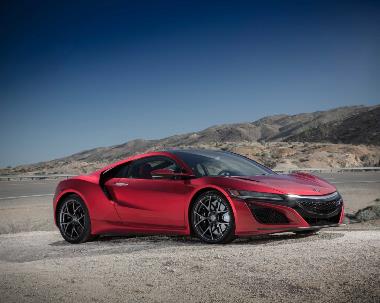
2017 Acura NSX: Twin Turbo Sports Car Deserves Supercar Consideration
Thursday, Jan 12, 2017
Automotive enthusiasts have a tendency to be excited by dynamic vehicles and often anoint them with the term “supercar.” This leads to what I perceive …Automotive enthusiasts have a tendency to be excited by dynamic vehicles and often anoint them with the term “supercar.” This leads to what I perceive as an overuse or misuse of the term. Having said that, a new imagining of an old vehicle certainly deserves consideration of the supercar label for its design, innovation, driving excitement and its horsepower -- 573hp. That vehicle is the 3-engine, 2017 Acura NSX.Show More
The original Acura NSX debuted in 1990 as a cutting-edge coupe combining exotic car styling and performance with a new dimension of quality, exceptional ergonomics and dynamic poise. It underwent a performance upgrade in 1997 and facelift in 2002 before being discontinued in 2005. NSX is back for 2017 as a lightweight, naturally aspirated coupe that can be perceived as a hybrid supercar, with a twin-turbo engine combined with a hybrid setup, and dual-clutch transmission. The new NSX rides on an aluminum-intensive space frame with a carbon fiber floor and a body designed to direct airflow over, under, and through the car including cooling duties.
Winter weather closed my test track, so I was unable to prove the estimated top speed of 191mph or the manufacturer’s estimate of a 3-second-flat zero-60mph sprint; and the NSX probably should be tested in spring or summer to fully enjoy the experience; but we never look gift horsepower in the trunk, so an exciting ride in winter was better than no ride at all.
Designed with elegance, NSX is constructed with a multi-material space frame of cast aluminum nodes and a mix of light aluminum and low-density SMC outer panels. The architecture features a wedge shape with prominent cooling ducts on the rear fenders, a conservative rear spoiler, and no active aero components (such as an active rear spoiler or active front grille shutters). Complex high-performance aluminum castings for crush zones is the world's first automotive application of the technique, as are the A-pillars made from 3DQ ultra-high-strength steel and a use of Carbon Fiber front floor panels.
Sitting on a wheelbase of 103.5 inches, with a length of 178 inches, height of 47.8 inches, width of 87.3 inches and a curbweight of only 3803 lbs., the NSX provides stability and speed by managing air flow through the front motor room and rear engine room as well as around the body, while still maintaining the increased stability of properly distributed downforce. Stability at speed is what the NSX delivers with exceptional balance and confidence to enhance the driving experience.
And there’s exceptional power. Maximum total system power is 573hp with maximum total system torque of 476 lb.-ft. The next-generation Sport Hybrid SH-AWD power unit consists of an all-new longitudinally mid-mounted twin-turbocharged 3.5-liter DOHC V-6 that puts out 500 hp and 406 lb.-ft of torque, and a permanent-magnet, water-cooled electric motor/generator direct drive motor. This system delivers 47hp and 109 lb.-ft. and is mated to a 9-speed dual-clutch transmission
On the road, stability is track-worthy and acceleration is immediate with the electric motors engaging before the twin turbos kick in. In tight quick turns you have to be on your toes because there is a lot of understeer, but the system softens torque steer and I wouldn’t be surprised if the 3-second factory hype on a zero-to-60 sprint is close to reality. My road-hugging pedal mashing averaged 20.7mpg in town and on the interstates.
The NSX cockpit is cozy, elegant, intuitive and filled with electronics. With seating capacity for two, NSX provides 38.3 inches of headroom, 42.8 inches of legroom, 57.6 inches of shoulder room and 54.5 inches of hip room.
Intuitive instrumentation, Alcantara® leather, well-padded sports seats, steering wheel and center console, exemplary ergonomics and a center console/control set-up designed to minimize distractions from the most important function – driving – combines with state-of-the-art connectivity and infotainment and more than a dozen active and passive safety features to provide a super interior experience.
In Curva Red – there’s not much better than a red sportscar -- the 2017 Acura NSX starts at $156,000. The Ebony interior was enhanced by Semi-Aniline Full Leather Alcantara® power seats for an additional $2500. Pricey exclusive wheel designs were available but the standard Y-spoke wheels were classy as they were. Brake packages for $10,000 or more were available, but the standard iron rotors with Black calipers served my test ride well. The Exterior Sports Package with a Black front spoiler, Black side sills, Black rear diffuser and chrome exhaust finisher was pretty cool, and we did without the $9000 Carbon Fiber rendition of the package. The same can be said for the body color rear decklid that was kept rather than to upgrade to Carbon Fiber for an additional $3000, as well as the spiffy NSX engine cover that could have been upgrade to Carbon Fiber for $3000. The standard interior package included a leather-wrapped steering wheel, Metallic Silver steering wheel spokes, Alcantara® meter visor and Black rubber pedals and footrest. An available Carbon Fiber upgrade was not included and would have cost $2900. One upgrade that was made on my test ride was an ELS Studio® Audio +Tech + SiriusXM Package for $3300 that upgraded a standard premium audio system to an ELS Studio® Premium Audio System with AcuraLink® The Next Generation, navigation, proximity sensors and XM Radio. A Black Aluminum roof antenna was also added as was Illuminated door sill trim inside (and this time Carbon Fiber was included) for $1500. Destination handling is $1800, which put the price as tested at $165,100.
> Visit www.CarlisleEvents.com for more on the automotive hobby.
Mike Blake, former editor of KIT CAR magazine, joined Carlisle Events as senior automotive journalist in 2004. He's been a "car guy" since the 1960s and has been writing professionally for about 30 years.
Book with a preferred Hotel

Book online or call (800) 216-1876
